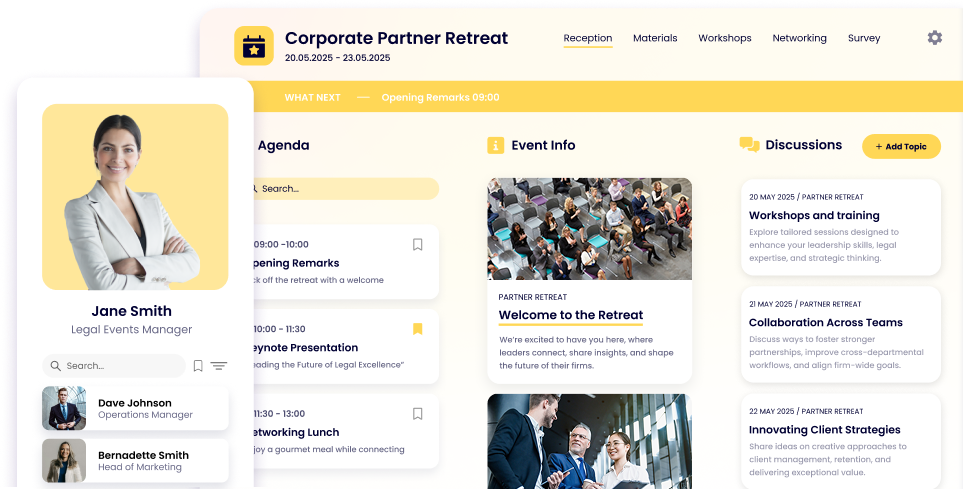Mastering Idea Generation: A Comprehensive Guide to 30+ Techniques, Tools, and Tips

Niamh Conneely | Marketing Executive
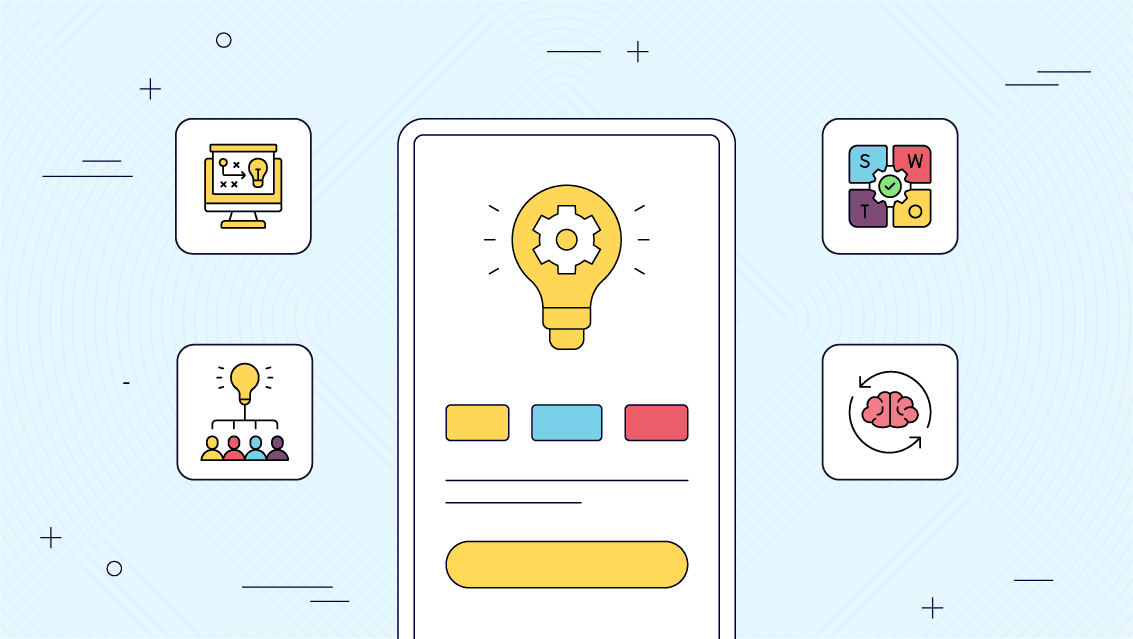
Idea generation is a fundamental process that transcends industries and fields. It’s the driving force behind innovation and progress.
Harvard Business Review contacted research from data of 3.5 million employees which concluded that higher ideation rates are correlated with growth and net income, most likely because companies with an innovation culture not only generate more unique solutions to market challenges but also encourage a proactive approach to addressing future industry shifts and customer needs. McKinsey & Company second this as they state companies that focus on innovation perform much better, generating over 2.4 times profit as other businesses
In this blog, you will be provided with a comprehensive understanding of idea generation, drawing insights from various sources. Whether you’re a student, a professional, an entrepreneur, or simply someone eager to boost their creative thinking, this guide is tailored to help you become a proficient idea generator. We’ll delve into practical techniques, strategies, and tools to empower your creative potential, enabling you to generate fresh ideas that can make a real impact.
Defining Idea Generation
Idea generation is the vital initial step towards advancement in the fields of creativity and innovation. It’s a skill that can be used in any sector or industry and crosses all barriers. The process of conceiving new ideas, concepts, or possibilities is known as idea generation. The great thing about idea generation is that it is not an exclusive skill, it can be learnt by anybody. It involves going against conventional thinking and embracing the unique and more unexplored ideas.
The relationship between idea generation and innovation
Innovation and idea generation go hand in hand, supporting each other in the creative journey. When you generate fresh ideas and nurture them, you’re laying the groundwork for innovation.These fresh ideas are the key ingredients of innovation, each holding the potential to transform industries and solve complex challenges. As these ideas evolve, they become the driving force behind groundbreaking innovations—real-world solutions that make a difference.
In the upcoming sections of this blog, we’ll explore practical techniques and strategies to help you unlock your idea generation potential.
Powering your idea generation with Fliplet
Fliplet’s Idea Management solution is a comprehensive platform designed to streamline idea generation and innovation management processes. It facilitates collaboration among team members, enabling them to propose, discuss, and prioritize ideas seamlessly. Fliplet’s solution not only centralizes the entire innovation cycle but also empowers organizations to capture and harness the collective intelligence of their workforce. It acts as a catalyst for innovation, ensuring that promising ideas are nurtured, developed, and transformed into impactful solutions.

The Significance of Idea Generation for Businesses and Entrepreneurs
Idea generation holds a paramount role in the world of business and entrepreneurship. It acts as a compass guiding organizations and individuals toward success. Here, we’ll explore the vital aspects of idea generation for businesses and entrepreneurs.
Identifying New Opportunities for Growth and Competitiveness
Idea generation is the driving force behind spotting new opportunities. It’s the process that allows businesses to explore uncharted territories, discover untapped markets, and develop innovative products or services. By continuously generating fresh ideas, businesses can stay ahead in the competitive landscape, ensuring long-term growth and relevance.
Refinement and Evolution of Existing Practices
Idea generation is not just about reinventing the wheel; it’s also about making the wheel smoother. It enables businesses to refine and evolve their existing practices. By adopting a culture of continuous improvement, organizations can identify areas where they can enhance efficiency, reduce costs, and deliver better value to their customers.
Importance of Involving the Right Stakeholders for Effective Ideation
Successful idea generation involves collaboration and input from various stakeholders. It’s essential to gather insights from employees, customers, and industry experts who bring diverse perspectives to the table. Engaging the right stakeholders ensures that the ideas generated are well-informed and aligned with the organization’s goals and values. It’s a collaborative effort that maximizes the chances of turning ideas into impactful solutions.
Techniques and Strategies for Idea Generation
There are a range of techniques and strategies to refresh your idea generation process, paving the way for innovative solutions and fresh perspectives. Some of them include:
Brain-based Techniques
Mind Mapping
Mind mapping is similar to creating a visual roadmap of your thoughts. It allows you to organize ideas, concepts, and connections. Its benefits lie in its ability to unravel complexity, aiding in problem-solving and idea generation. Use mind maps when tackling intricate challenges or when brainstorming for creative solutions.
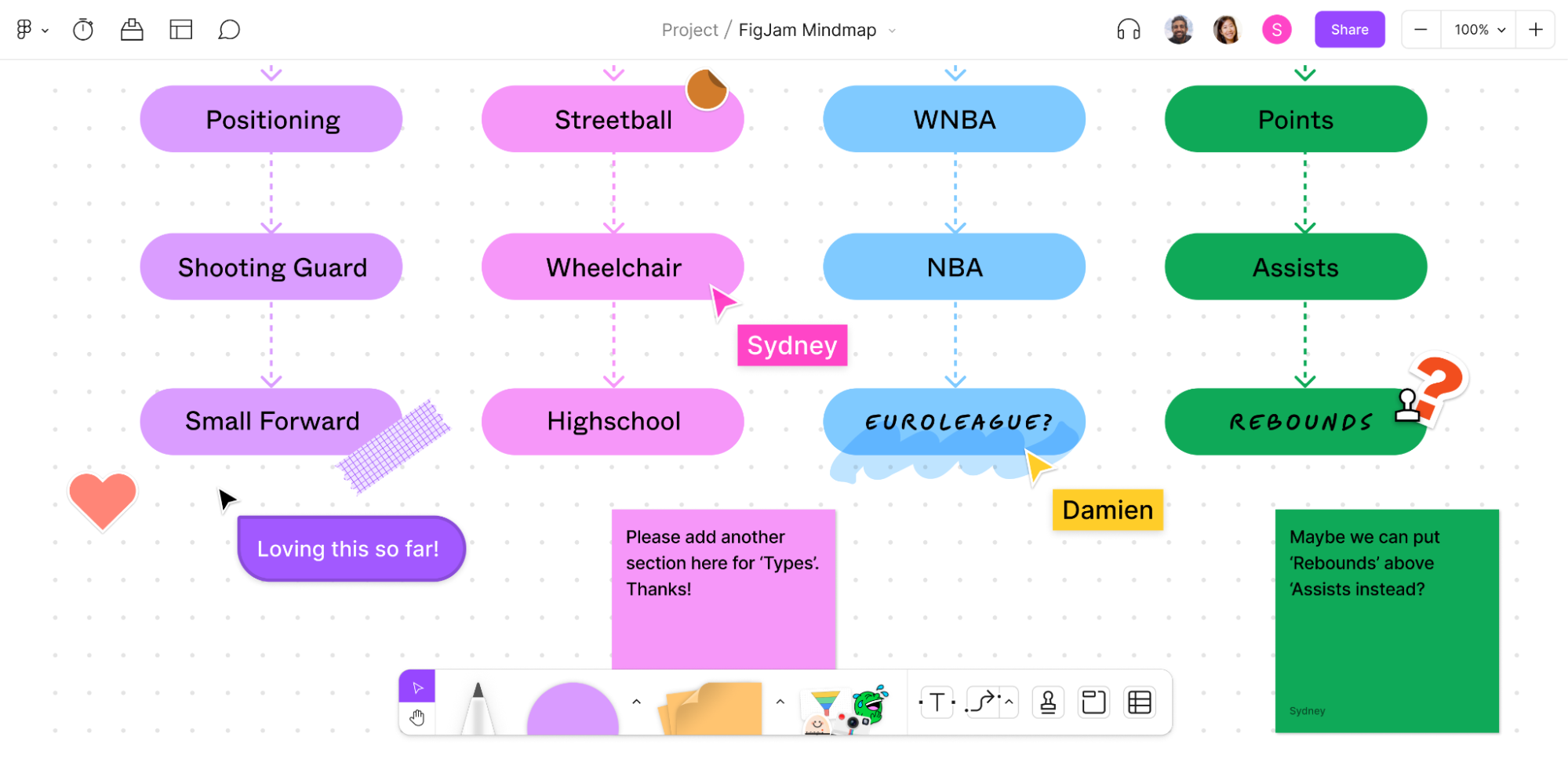
Figma is a tool you can use to help put your ideas into a mind map.
First Principles Design
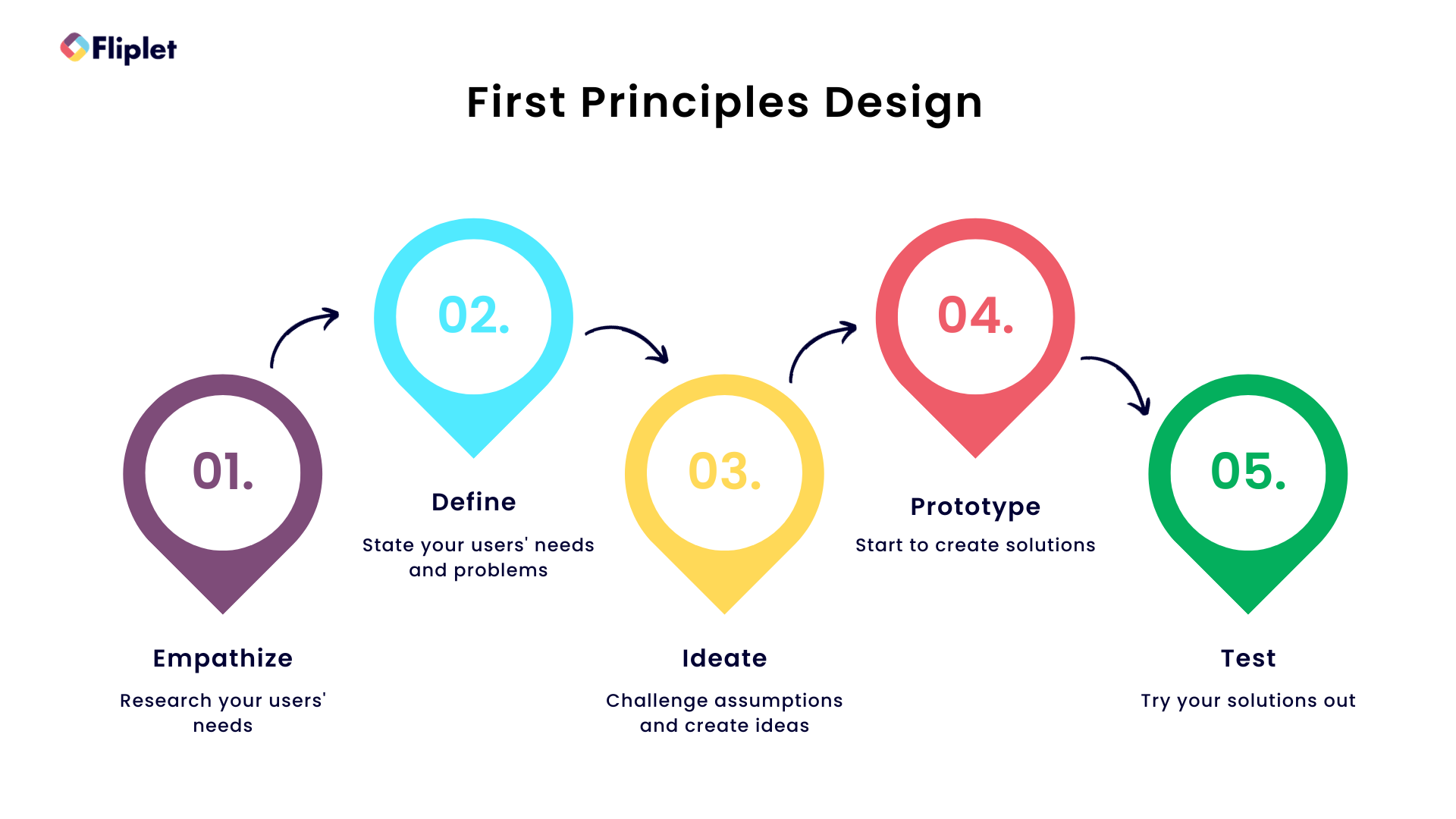
At its core, first principles design breaks problems down to their fundamental elements, stripping away assumptions and preconceived notions. By doing so, it encourages innovative thinking by rebuilding from the ground up. This technique is particularly useful when you need to reframe a problem or seek unconventional solutions.
Blue Sky Thinking/Brainstorming
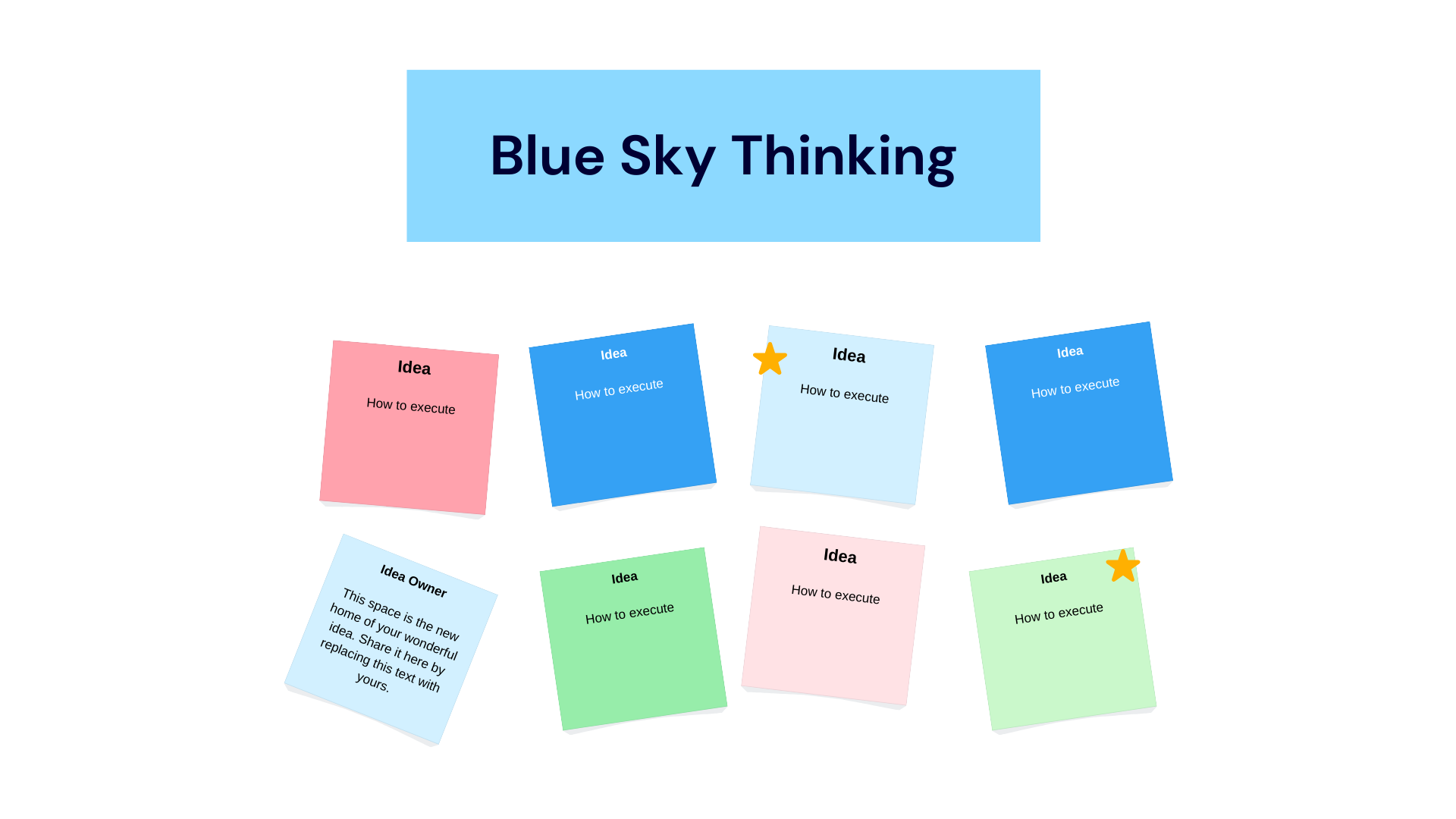
Blue-sky thinking, or brainstorming, is the art of generating ideas without constraints. It thrives on the principle of quantity leading to quality. By adopting an open and judgment-free environment, brainstorming allows diverse ideas to emerge, helping you explore a multitude of possibilities and uncover unexpected solutions.
Collaborative Techniques
Collaborative Innovation
Collaborative innovation harnesses the collective intelligence of a team. By bringing diverse minds together, you can draw from a pool of perspectives and experiences, increasing the likelihood of groundbreaking ideas. It’s ideal for addressing complex challenges that benefit from varied viewpoints.
Fliplet’s Innovation Management solution serves as an excellent collaborative tool by seamlessly bringing together diverse minds, allowing teams to pool their perspectives and experiences, ultimately enhancing the chances of generating new ideas.

“Yes, and…” (Improvisation Technique)
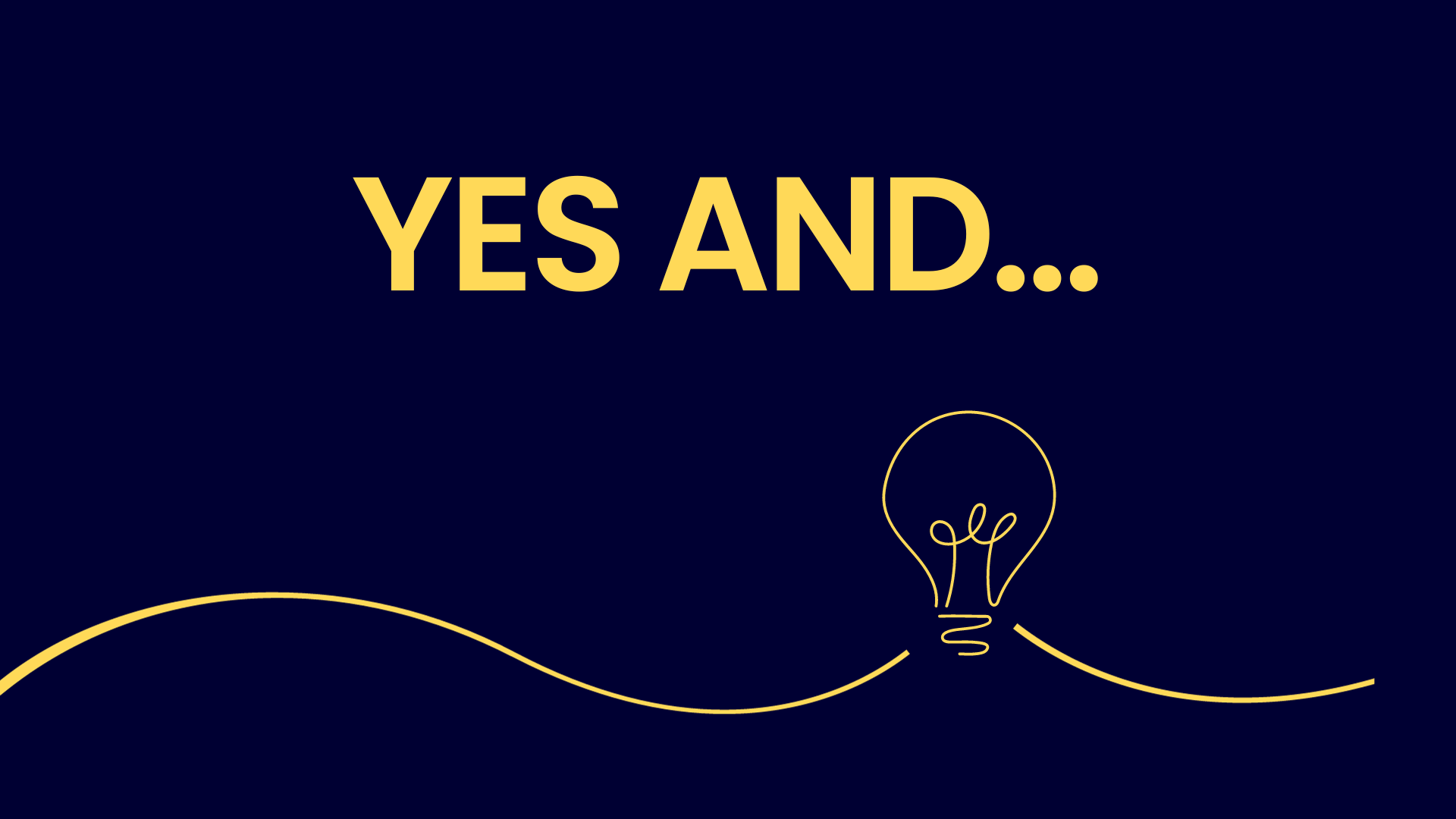
Inspired by improv comedy, this technique encourages building upon ideas rather than negating them. By accepting and expanding on each other’s suggestions, teams can create innovative solutions. It promotes a culture of creativity and collaboration, making it suitable for idea generation sessions that thrive on synergy.
Role Playing/Role-Storming
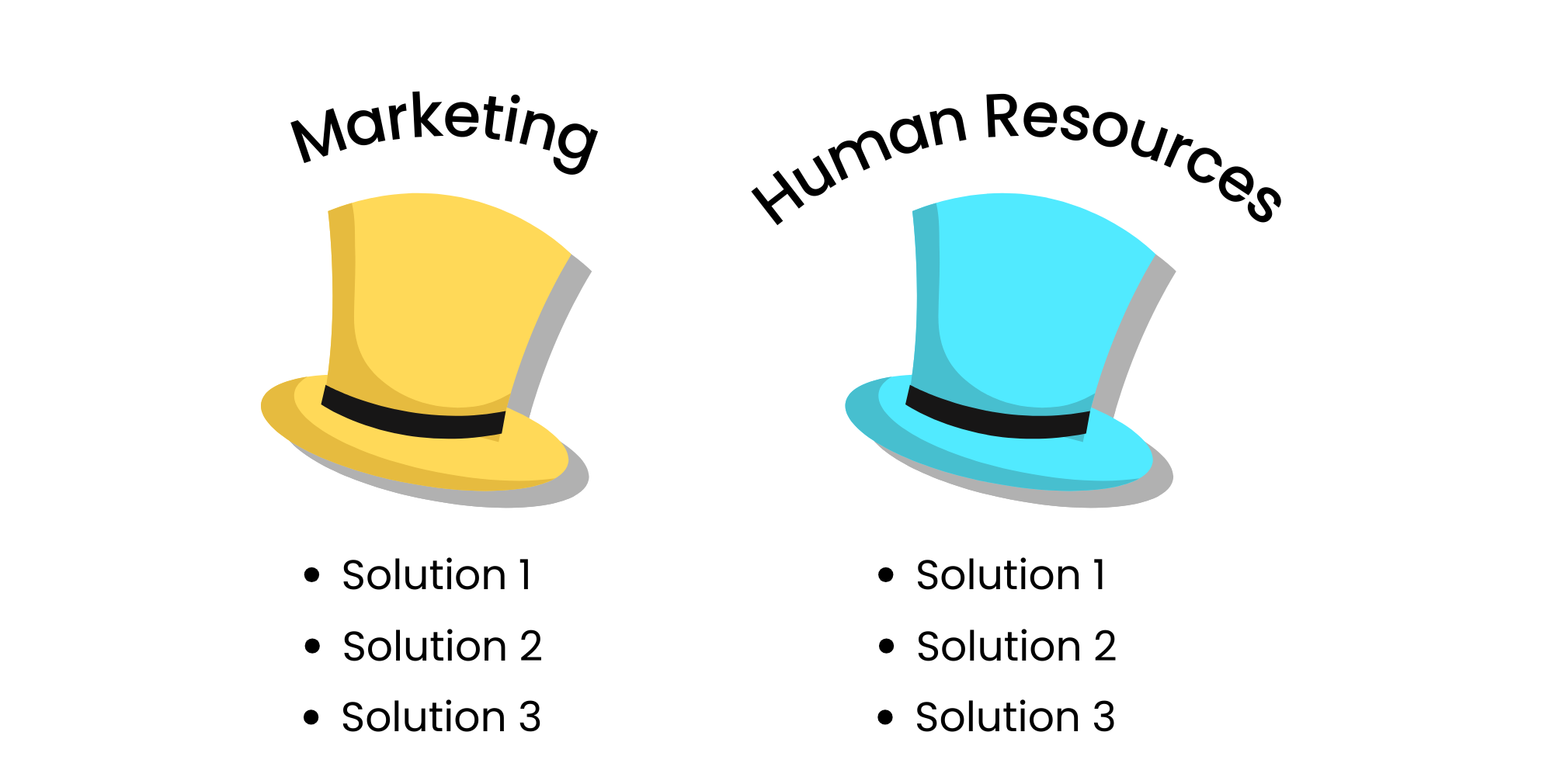
Stepping into different roles allows individuals to explore problems from various perspectives. It’s like viewing an issue through different lenses, which can be particularly valuable when brainstorming solutions that require empathy and understanding of diverse stakeholder viewpoints.
Analytical Techniques
The 5W’s and the H
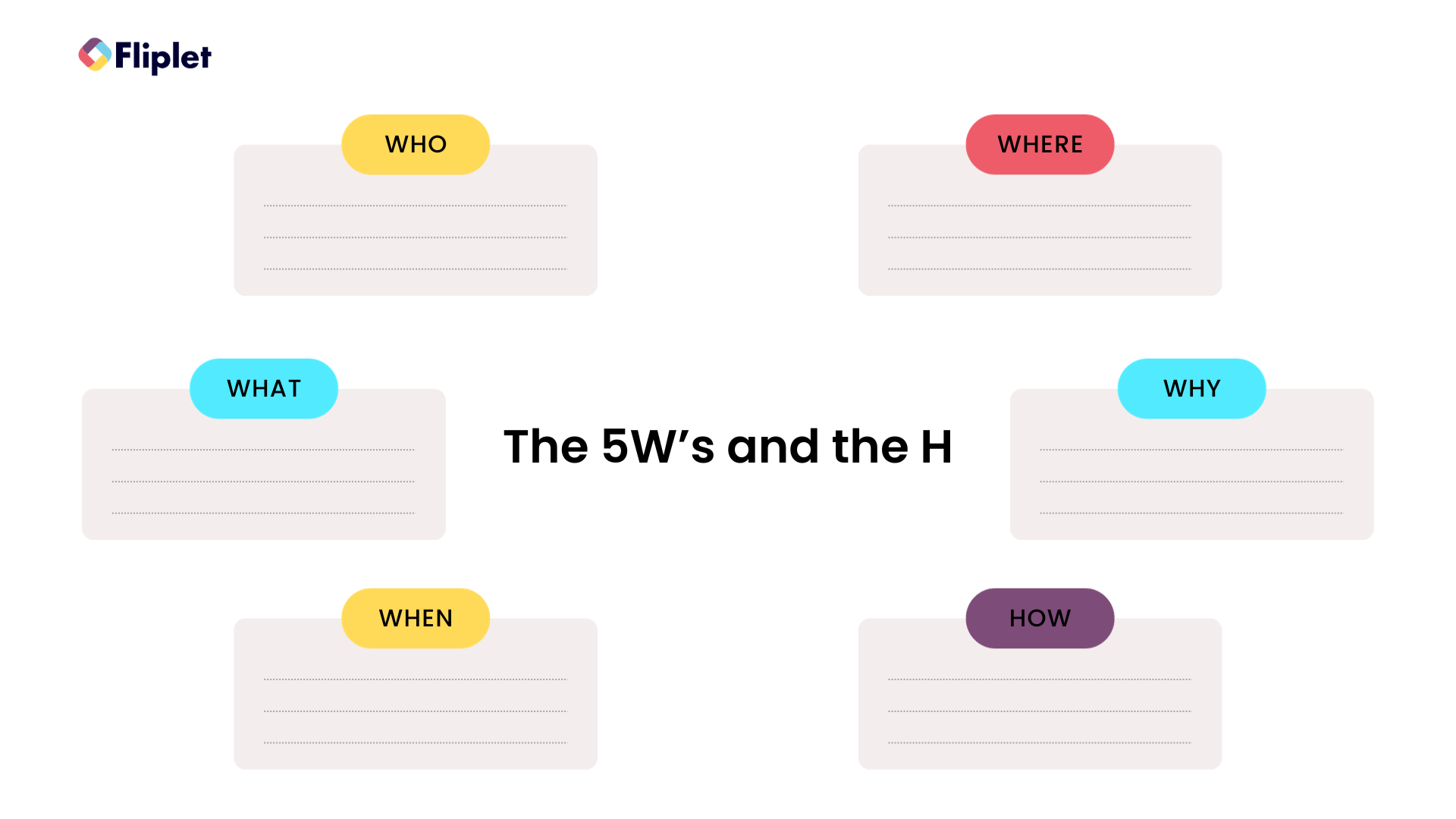
The “Who, What, When, Where, Why, and How” questions help dissect problems thoroughly. This structured approach ensures that you explore all aspects of an issue, providing a well-rounded foundation for idea generation.
SWOT Analysis
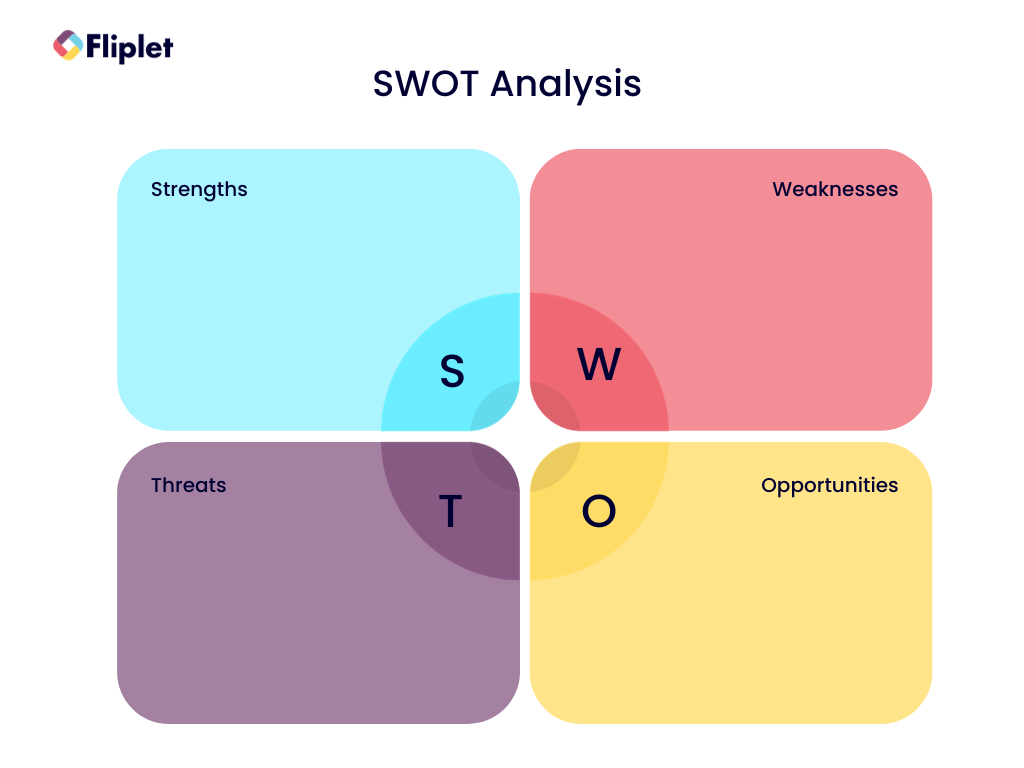
SWOT analysis evaluates Strengths, Weaknesses, Opportunities, and Threats. It’s an effective tool for assessing a situation’s internal and external factors, making it a valuable starting point for generating ideas aimed at capitalizing on strengths and seizing opportunities while mitigating weaknesses and threats.
Download this free SWOT analysis template.
Innovative Techniques
SCAMPER Technique
SCAMPER prompts you to Substitute, Combine, Adapt, Modify, Put to another use, Eliminate, or Reverse aspects of a problem or idea. This versatile technique encourages innovative thinking by challenging you to explore multiple dimensions and possibilities.
Here is the SCRAMPER technique explained
Opposite Thinking
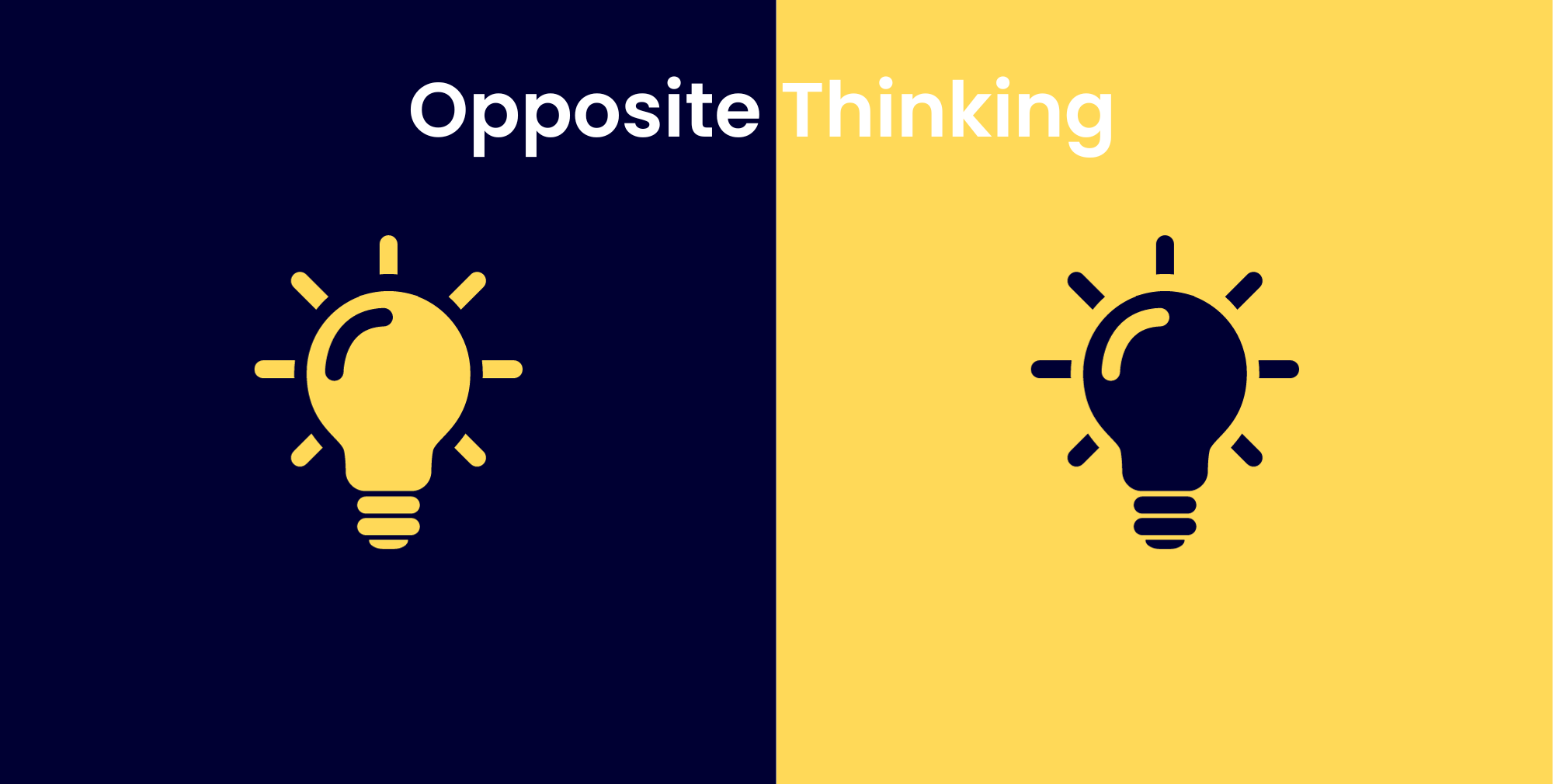
Opposite thinking encourages considering the exact opposite of conventional solutions. It challenges the status quo and prompts you to examine problems from a completely different angle, often leading to creative and unconventional ideas.
Brainstorm Cards
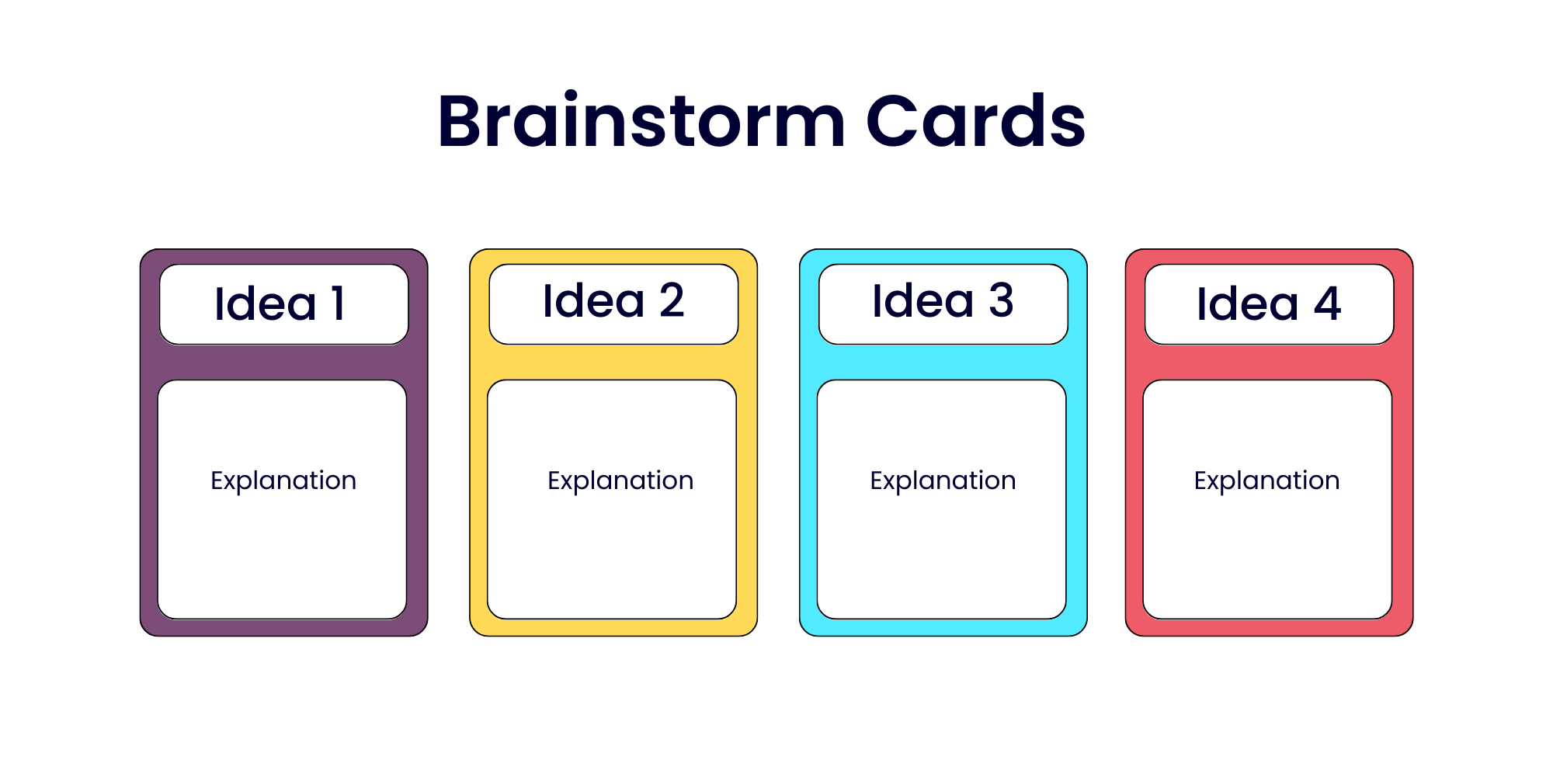
Brainstorm cards provide prompts or random words to kickstart idea generation. They serve as creative triggers, inspiring fresh angles of approach and encouraging out-of-the-box thinking.
Analogy Thinking
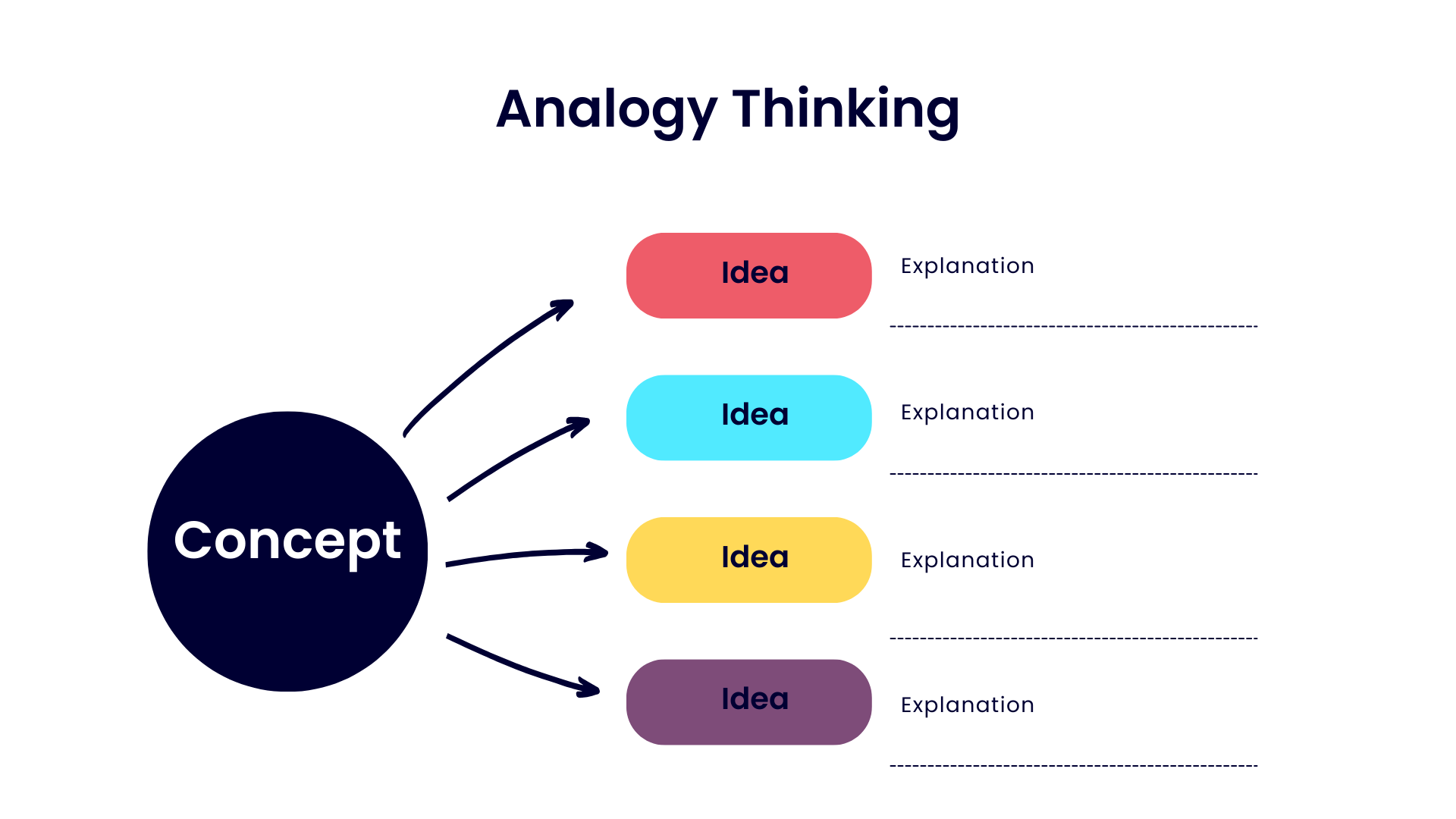
Drawing parallels with unrelated concepts can lead to unique insights and innovative ideas. Analogy thinking encourages cross-disciplinary idea generation by connecting seemingly disparate ideas.
Synectic
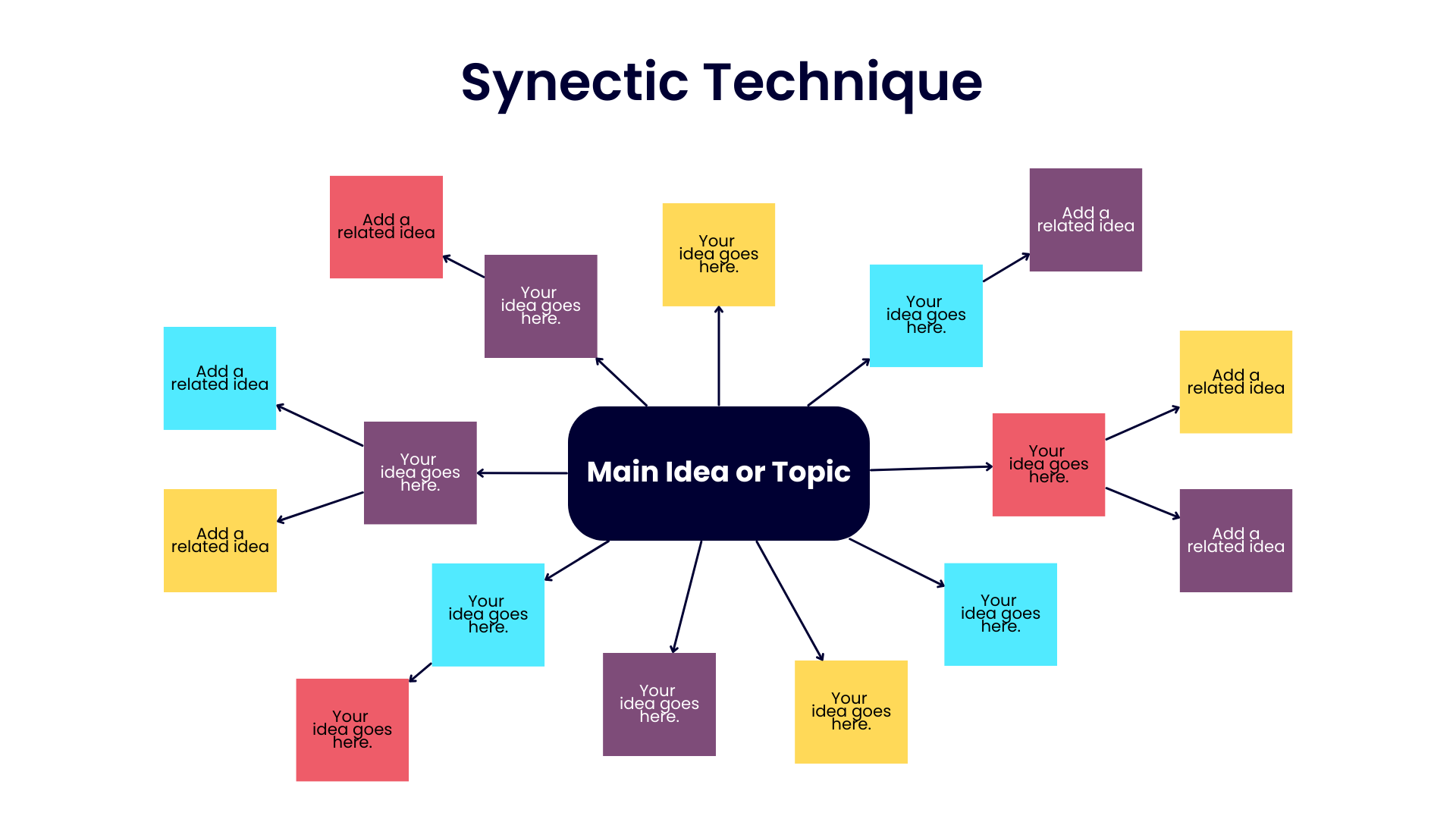
Synectic is a technique that combines unrelated elements to create something new. It invites you to explore the synergy between diverse concepts and ideas, often resulting in novel solutions.
Tech and Digital Aids
Social Listening

Social listening involves monitoring social media and online conversations to gain insights into customer preferences, trends, and pain points. It provides a real-time window into the thoughts and opinions of your audience, sparking innovative ideas for products, services, or marketing strategies.
Idea Management Tools

Idea management tools are digital platforms designed to streamline the ideation process. These platforms enable teams to submit, collaborate on, and evaluate ideas systematically. They promote organization and transparency in idea generation, ensuring that promising concepts are nurtured and developed.
Digital Platforms for Idea Collaboration
These platforms facilitate remote idea generation and collaboration, allowing teams to work together seamlessly regardless of their physical locations. They promote inclusivity and diverse perspectives, enhancing the quality and quantity of generated ideas.
Discover how a Fliplet client launched an idea collection app, achieving 170% above their target:
Advanced Techniques
Complex Opportunity Recognition
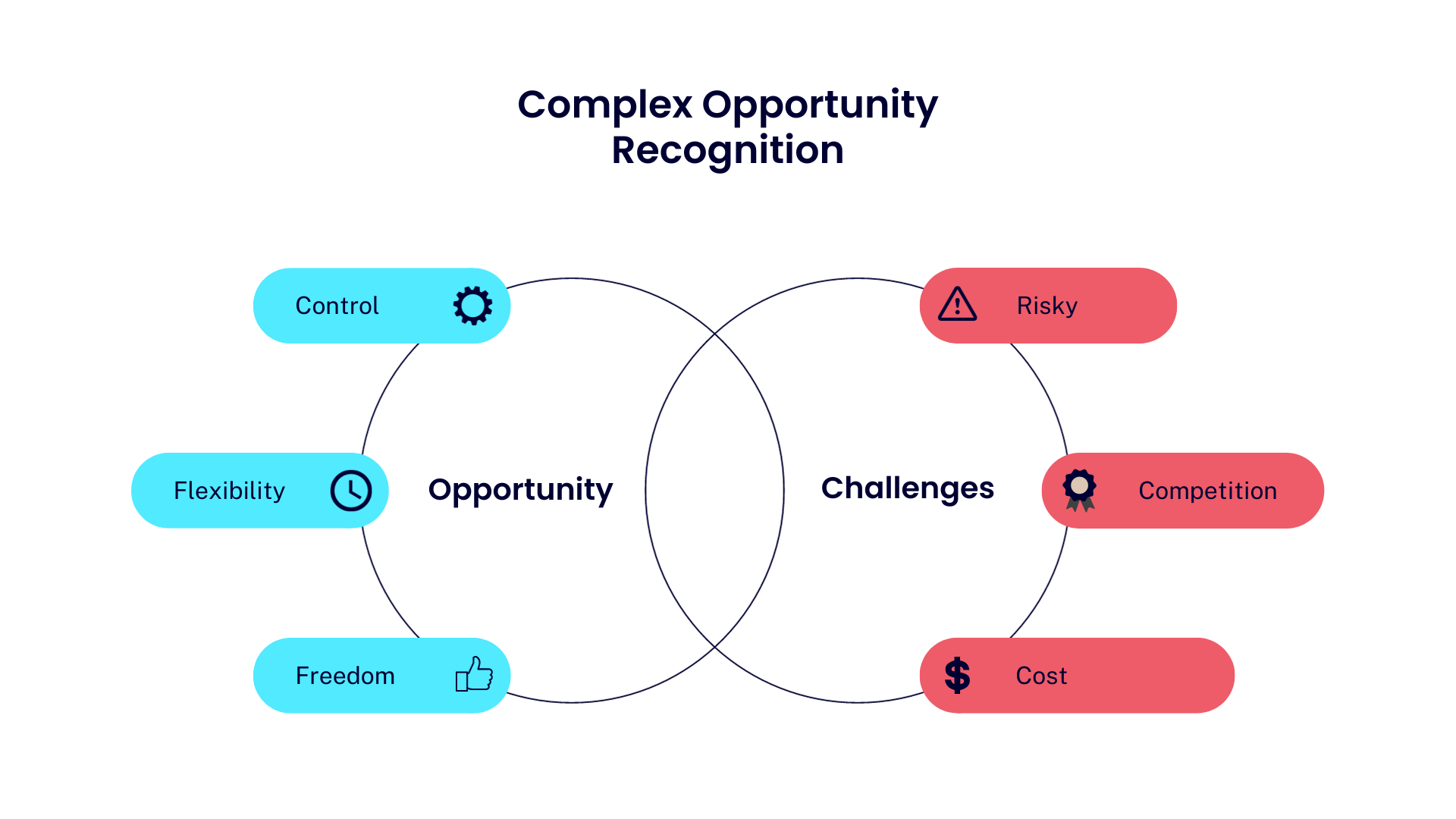
Identifying intricate opportunities within challenges requires a keen eye for detail and a holistic view of the situation. This advanced technique involves deeply analyzing complex problems to uncover hidden possibilities.
Product Trend Approach
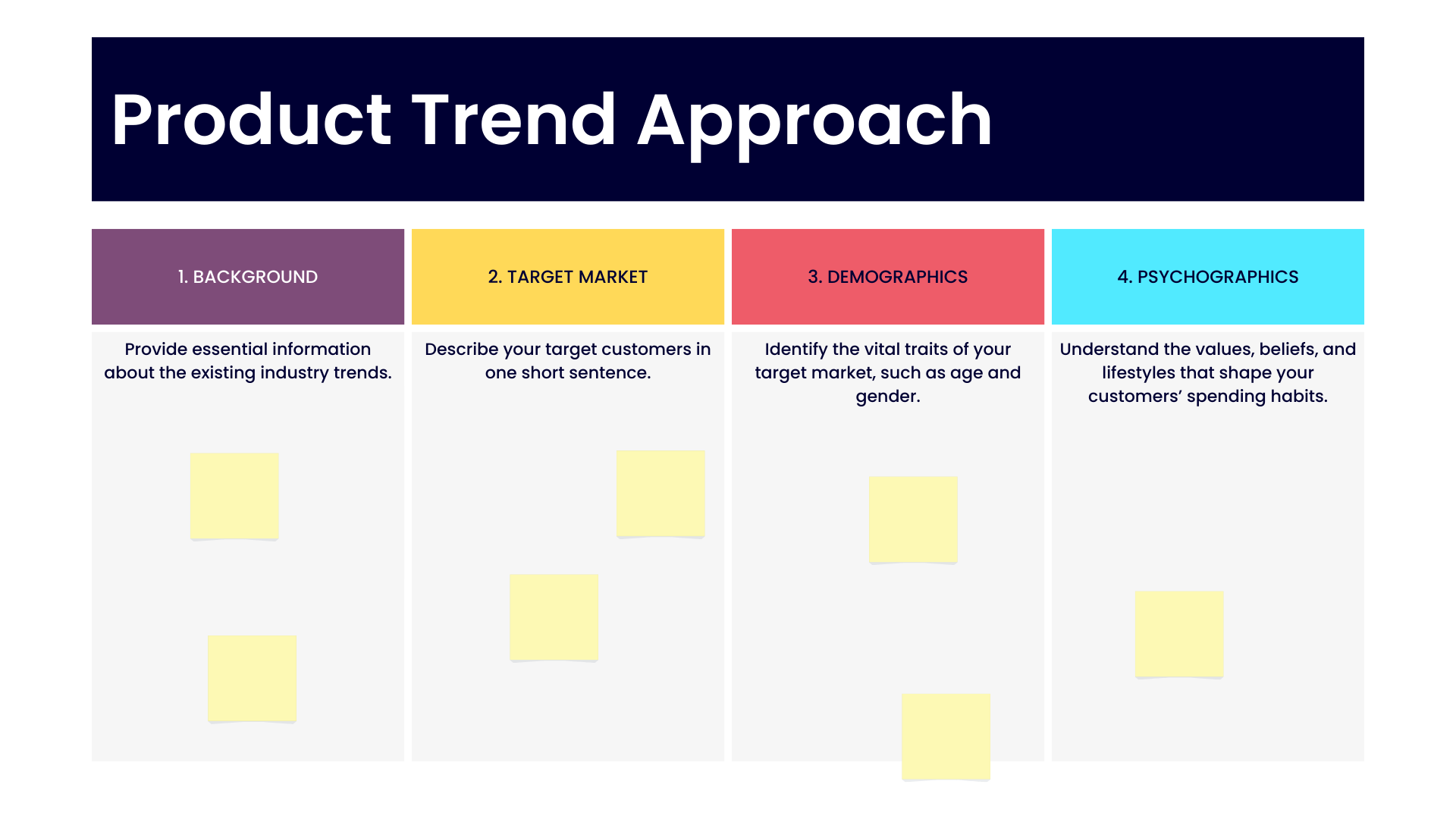
Analyzing market trends and consumer behavior can lead to innovative product ideas that align with current demands. By staying attuned to shifts in consumer preferences, you can identify opportunities for product innovation.
Innovation Mapping
Innovation mapping involves visualizing your innovation journey from idea to implementation. It helps you plan and strategize the path your idea will take, ensuring a smooth transition from concept to reality.
Here’s a video explaining innovation mapping:
Business Model Innovation
What makes Amazon, Spotify and Tinder so successful in such complex industries? The answer is Business Model Innovation. Take a look at this video to find out more:
Reimagining your business model can open doors to new markets and revenue streams. It involves exploring alternative ways to deliver value to customers and generate revenue, often resulting in innovative business strategies.
Storyboarding
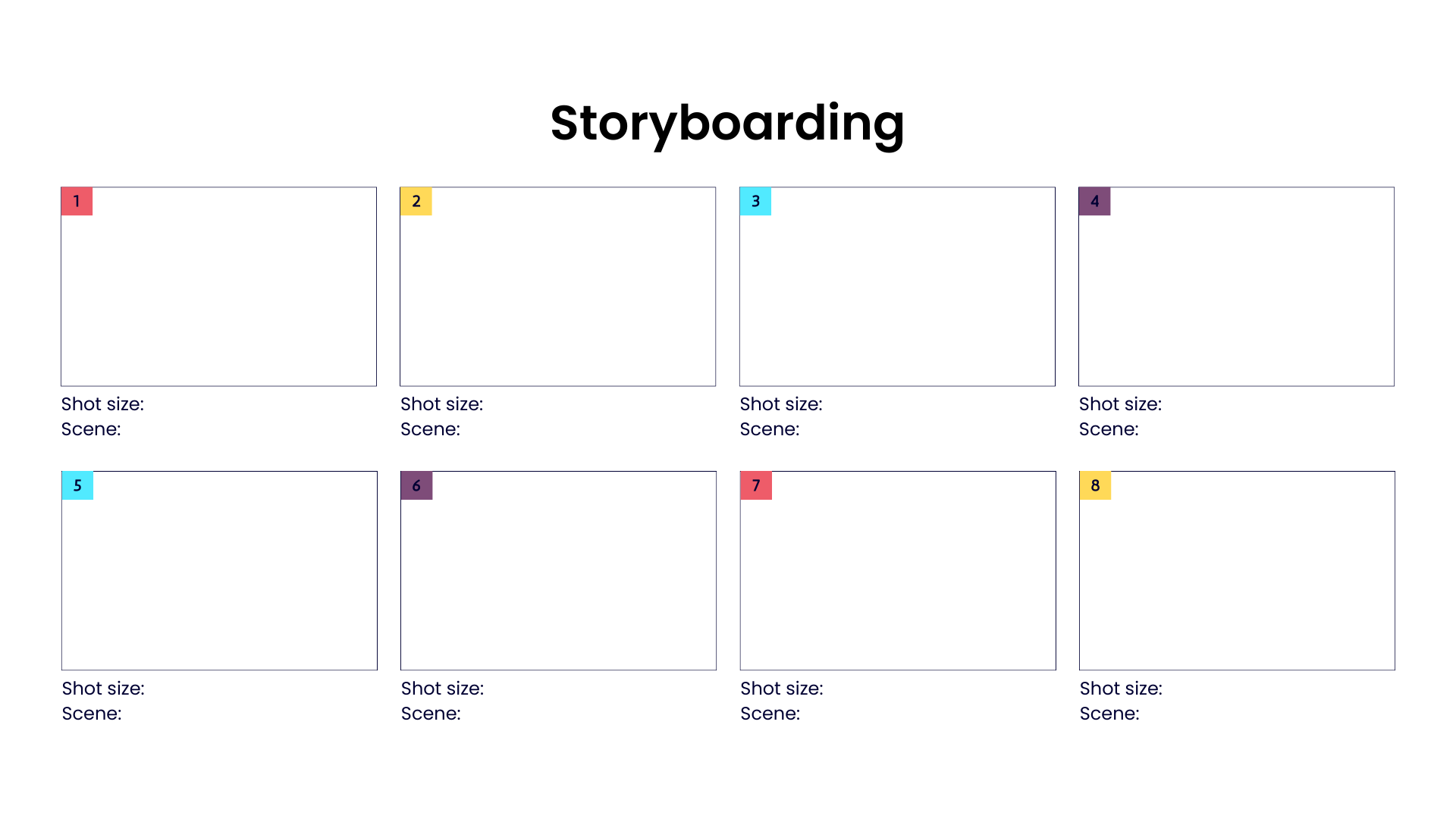
Visualizing ideas through storytelling allows for a more comprehensive exploration of concepts. It helps teams understand the user experience, functionality, and potential challenges associated with an idea.
Forced Relationships
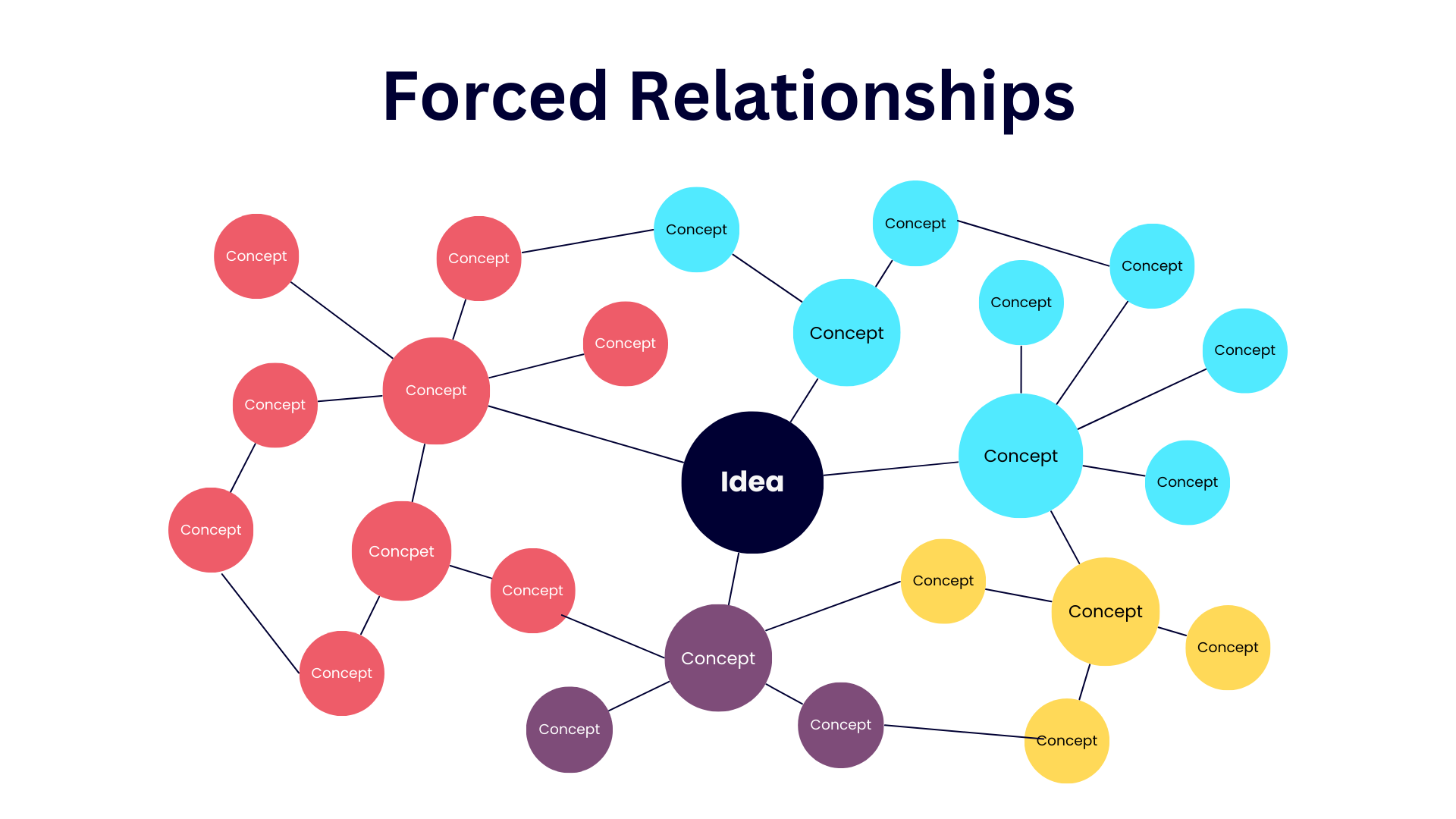
Forced relationships involve connecting seemingly unrelated concepts or ideas to create new insights. It encourages thinking outside the box and exploring unconventional connections.
Six Thinking Hats and other Decision-Making Models
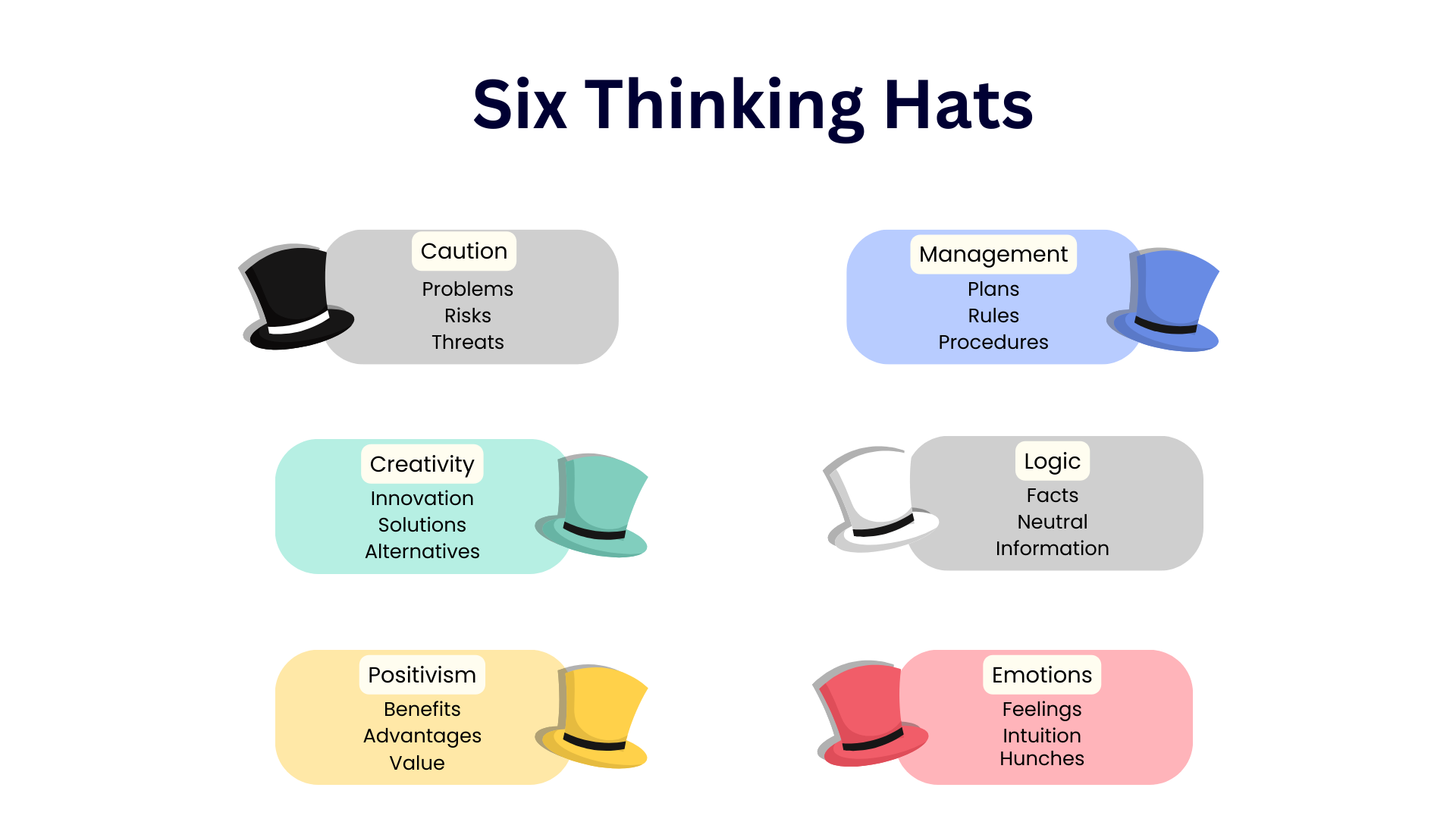
These models provide structured frameworks for thinking about problems and generating ideas. They guide individuals and teams through different modes of thinking, ensuring comprehensive exploration of ideas from various angles.
Techniques Beyond the Norm
Reverse Brainstorming/Thinking
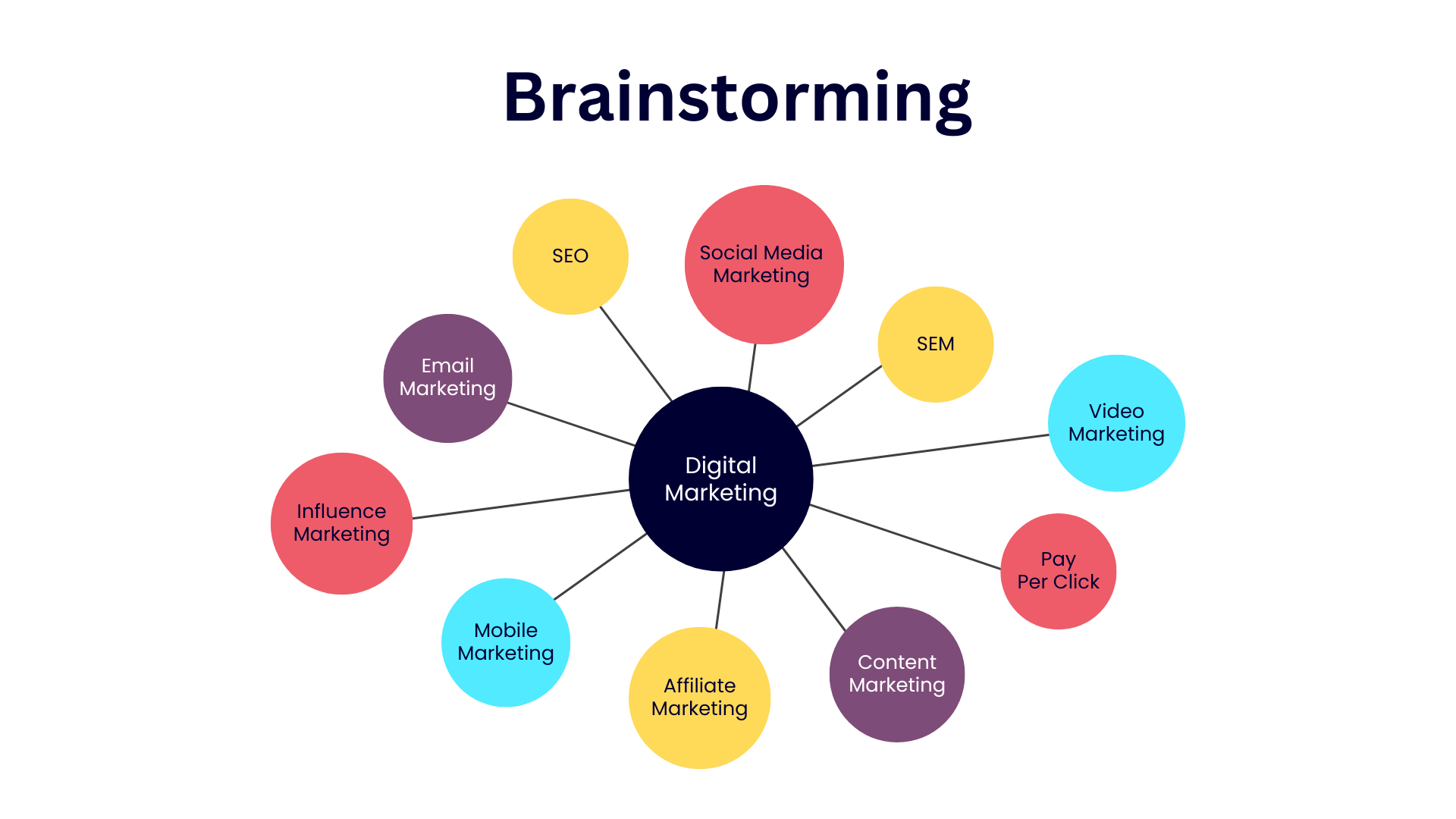
Reverse brainstorming involves identifying ways to worsen a problem or create obstacles. By considering what not to do, you can uncover innovative solutions to overcome challenges.
Brainwriting
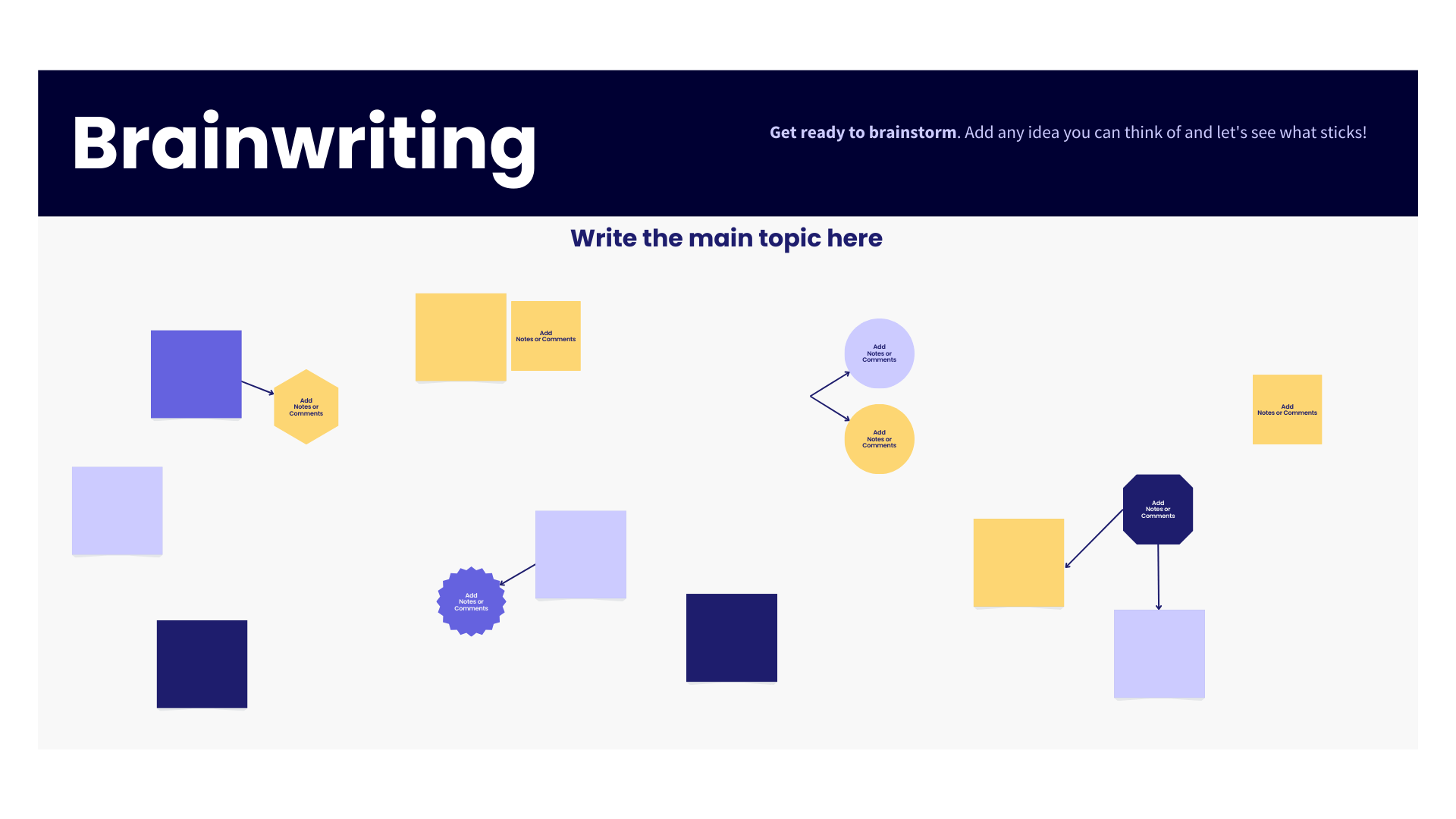
Brainwriting is a written form of brainstorming where individuals silently contribute ideas on paper. It promotes equal participation and can be less intimidating than traditional brainstorming sessions.
Brain netting

Similar to brainwriting, brain netting involves collecting ideas from multiple contributors but in a structured and collaborative manner. It encourages free thinking and diverse contributions.
Group Sketching
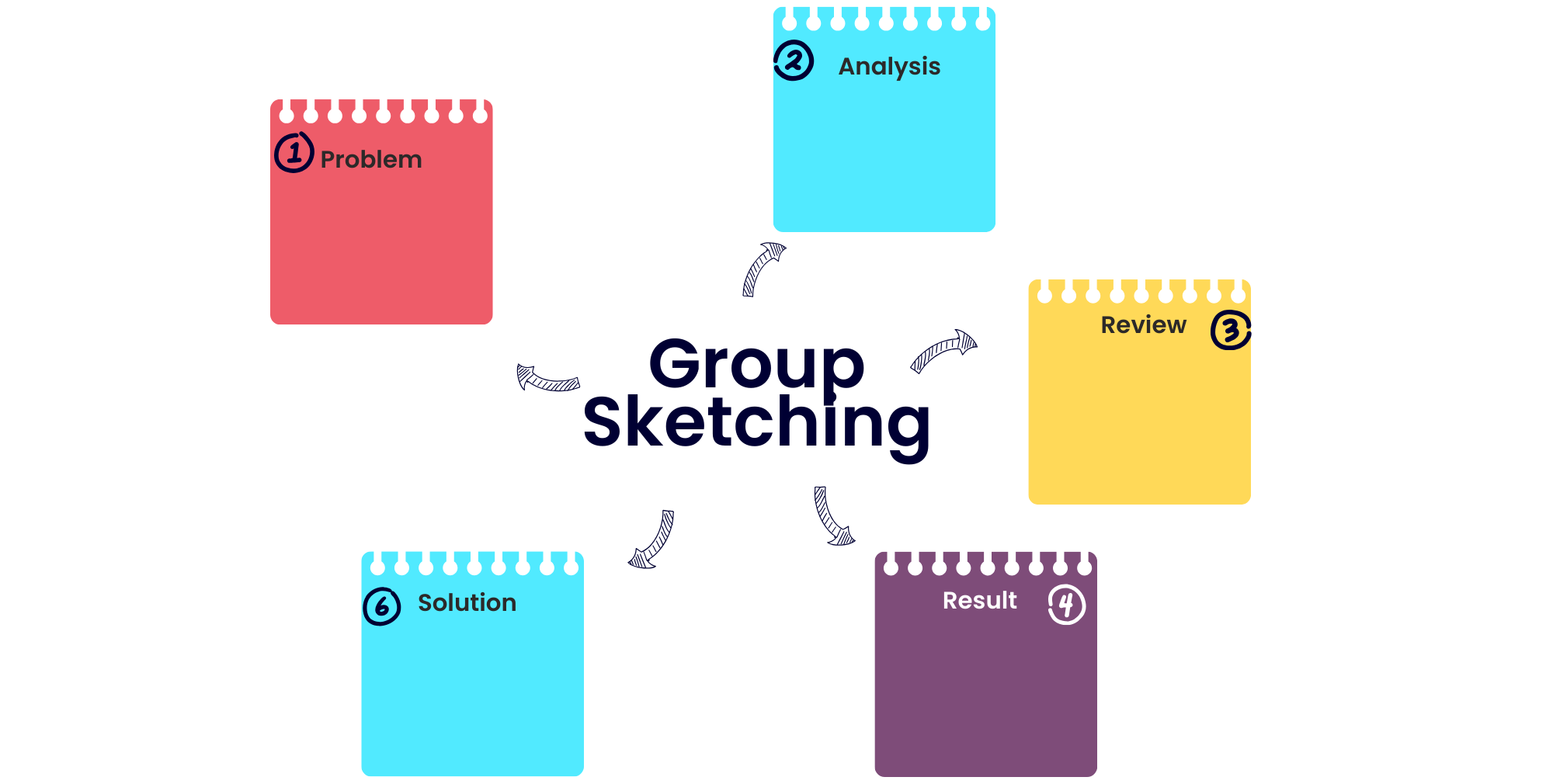
Group sketching involves visually representing ideas through drawings or diagrams. It’s particularly effective for teams with visual thinkers who can convey concepts more effectively through visuals.
Trigger storming
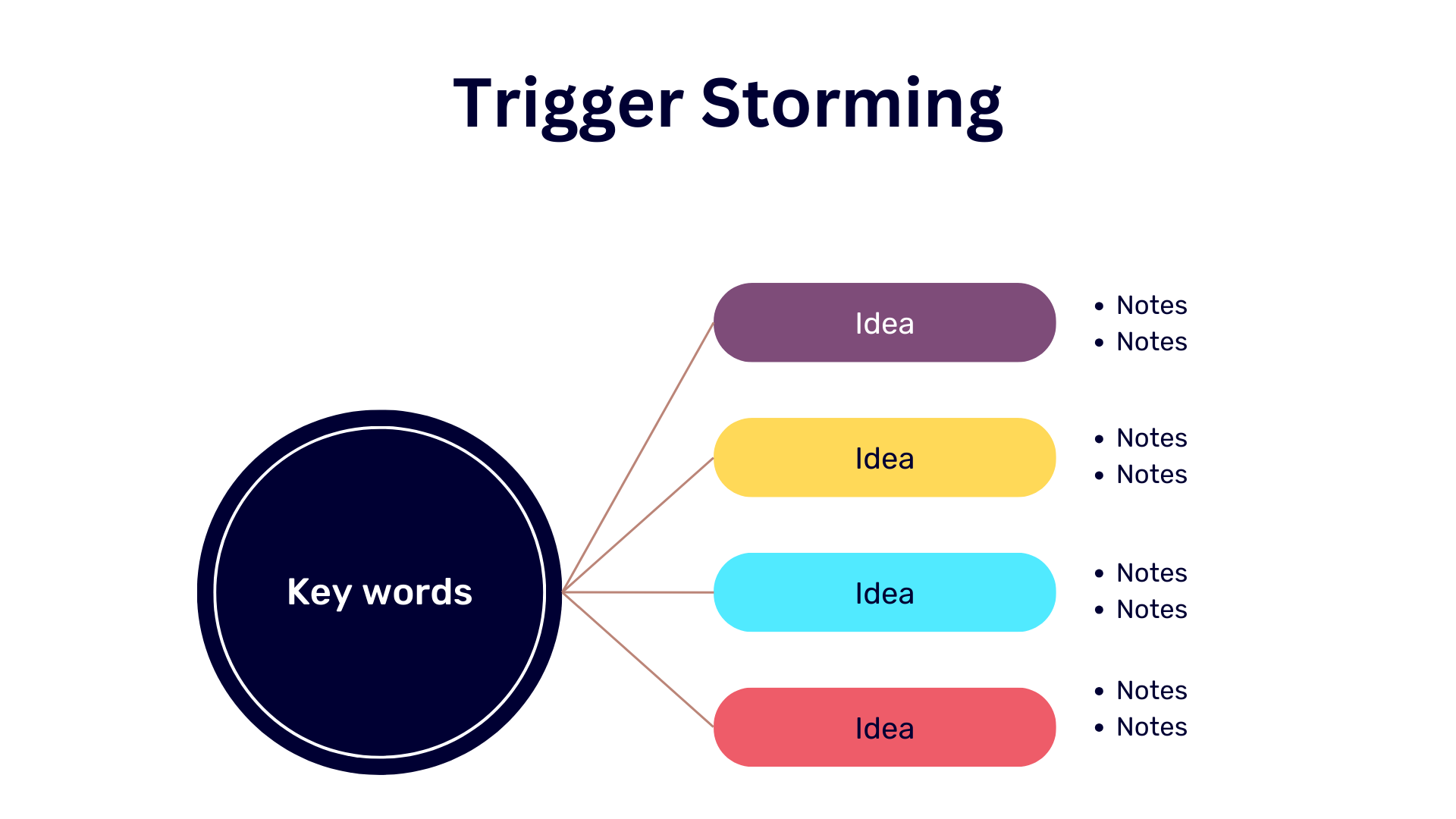
Trigger storming uses cues or triggers, such as images or keywords, to stimulate idea generation. It’s a creative technique that encourages spontaneous and imaginative thinking.
“What if” Scenarios
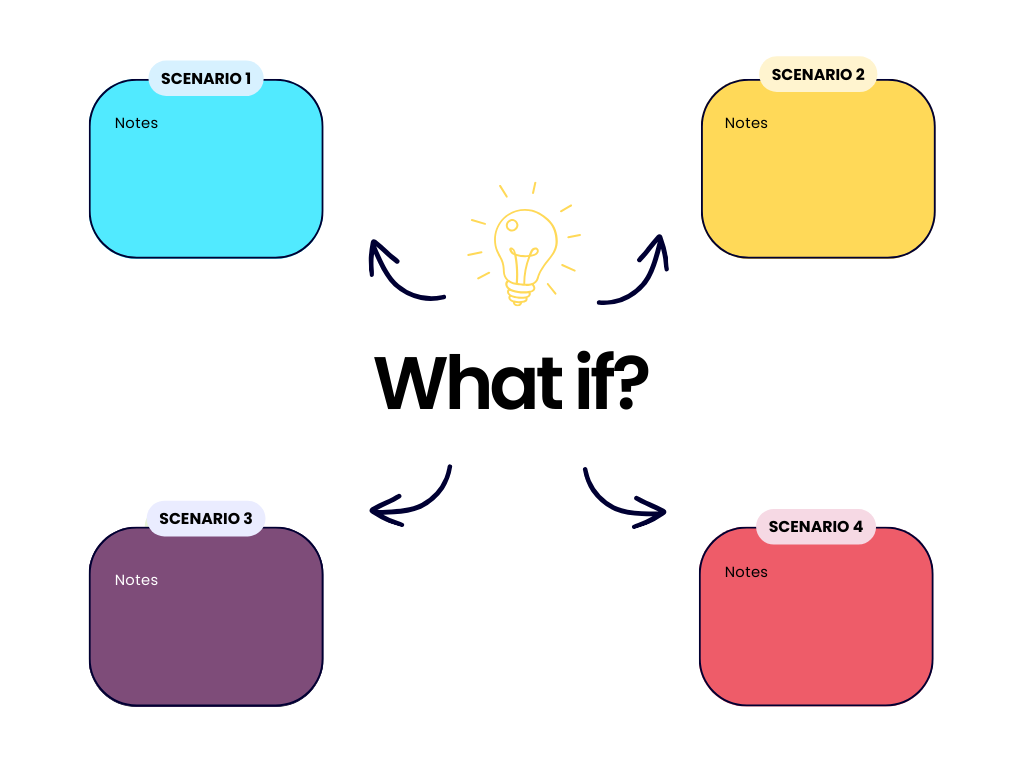
“What if” scenarios involve exploring hypothetical situations or scenarios. By asking “what if” questions, you can uncover unconventional ideas and innovative solutions.
Zero Draft
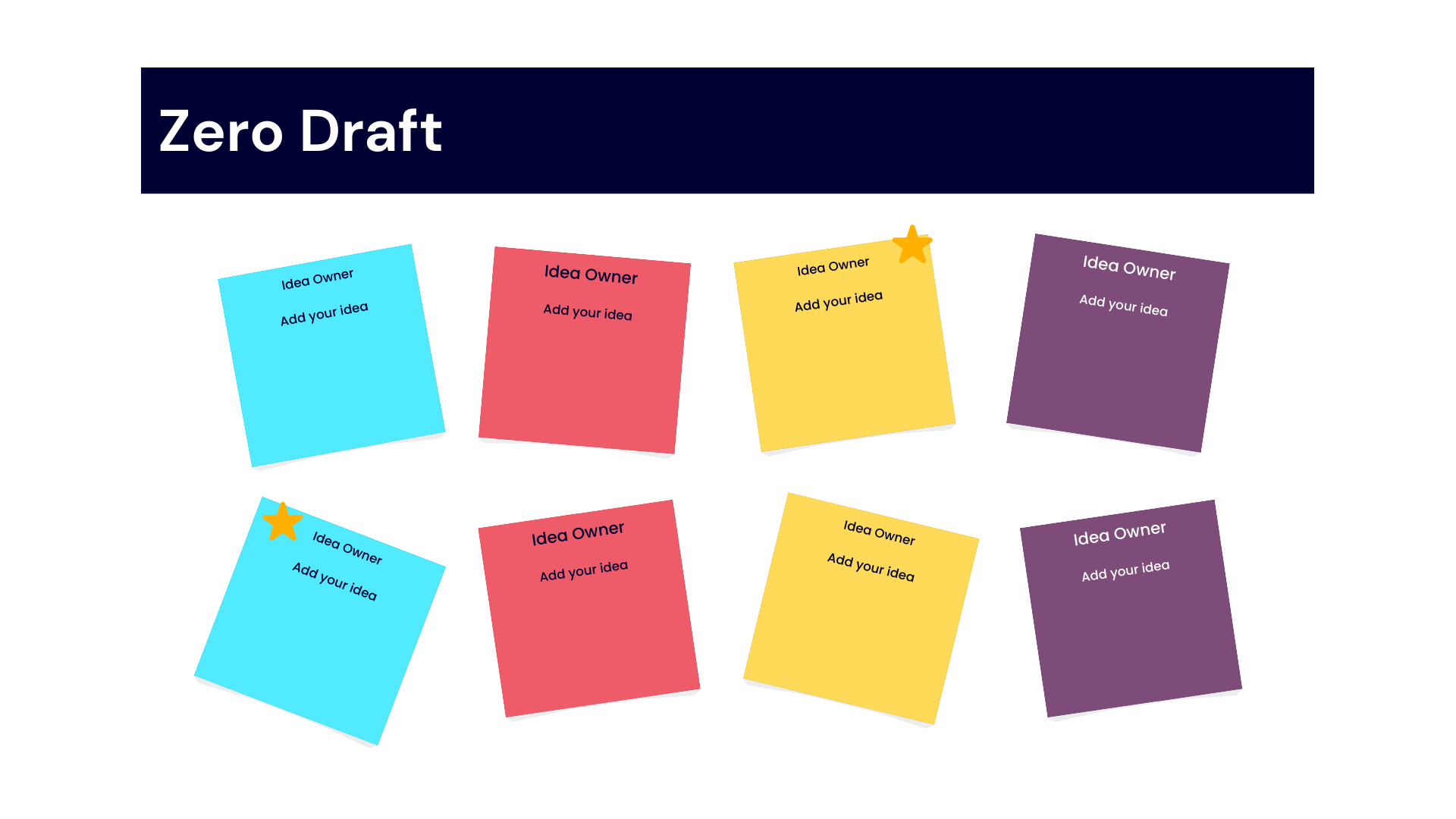
A zero draft is an initial, unstructured version of an idea or concept. It encourages free-flowing creativity without the constraints of perfection, allowing for raw and unfiltered ideation.
Selecting the Right Technique for your Team and Organization
Idea generation isn’t a one-size-fits-all endeavor. It’s a dynamic process influenced by various factors, including team size and specific goals. In this section, we’ll explore the art of choosing the right idea generation technique to match your team’s composition and objectives.
Selecting the Right Idea Generation Technique: Team Size vs. Goal
The path to effective idea generation begins with understanding your team’s dynamics and the goals you aim to achieve. The selection of the appropriate technique hinges on two key considerations: team size and the nature of your goal.
| Team Size Vs Goal Specific Solution | Specific Solution | Broader Brainstorming |
|---|---|---|
| Small Teams | Analytical Tools First Principles Design SCAMPER Technique | Traditional Brainstorming Mind Mapping Collaborative Innovation Opposite Thinking Brainstorm Cards |
| Large Teams | SWOT Analysis Forced Relationships Six Thinking Hats Decision-Making Models Digital Platforms for Idea Collaboration such as Fliplet | Idea Management Tools Collaborative Innovation Synectic "What if" Scenarios |
Tools that Can Help in Idea Generation and Innovation Management
Leveraging the right tools can significantly enhance the efficiency and effectiveness of your idea generation and innovation management efforts. Here are three essential tools, each playing a vital role in nurturing creativity and driving innovation:
When it comes to idea generation, having the right tools can significantly boost your creative potential. That’s where Fliplet can help. Fliplet offers an Innovation Management solution that caters to both individuals and teams. Fliplet can be a valuable platform in your creative journey. Fliplet provides a structured platform for brainstorming, collaborating, and nurturing your ideas.

Fliplet’s innovation solution features can help spark ideas. Some key features include:
Easily ask employees for solutions to urgent problems in your organization
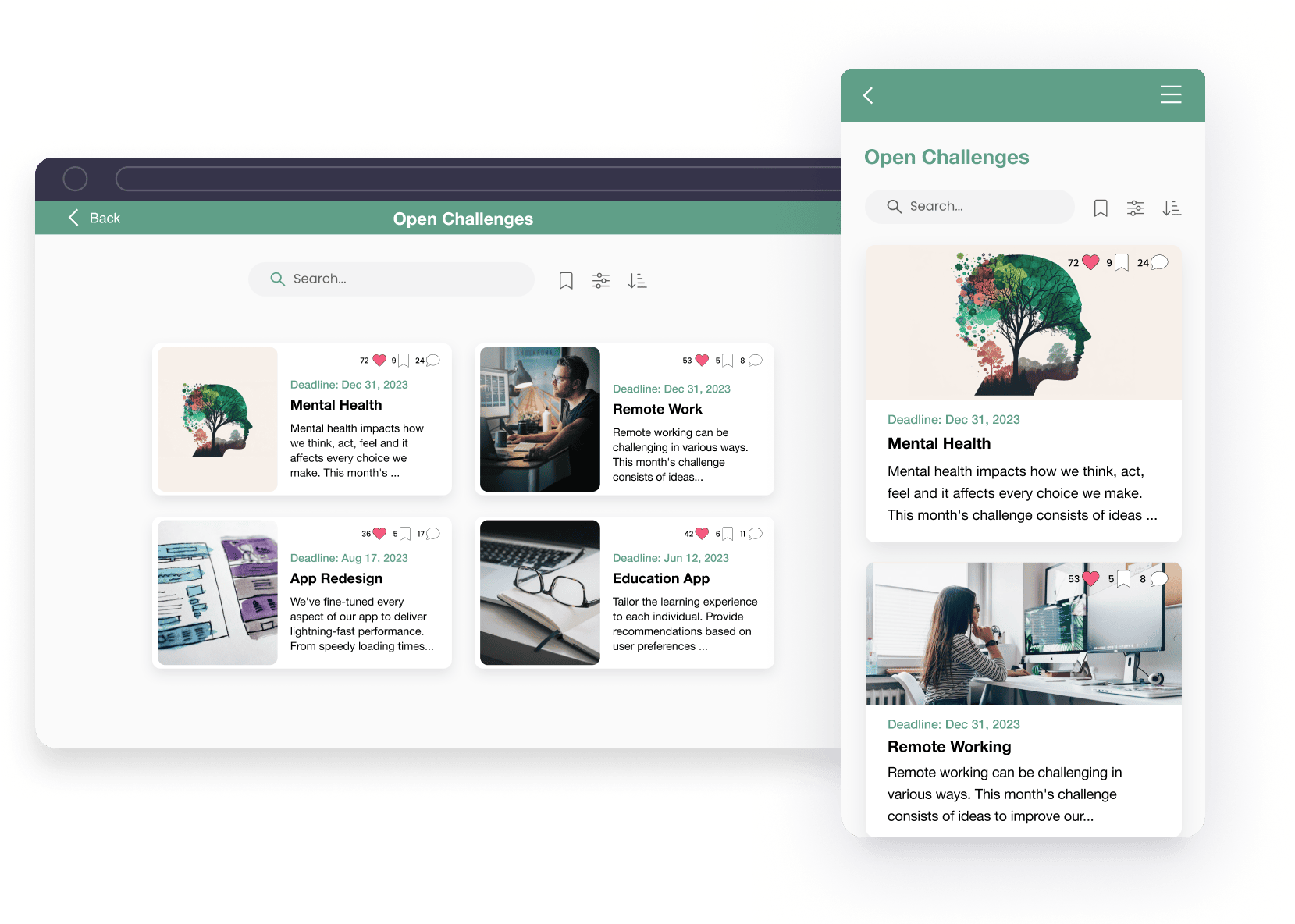
Fliplet’s innovation management software allows you to swiftly address pressing concerns within your organization. By creating specific challenges, you stimulate solution-oriented thinking among your team. This feature promotes proactive problem-solving, nurturing a culture of innovation.
Prioritize the innovative ideas with the biggest business impact
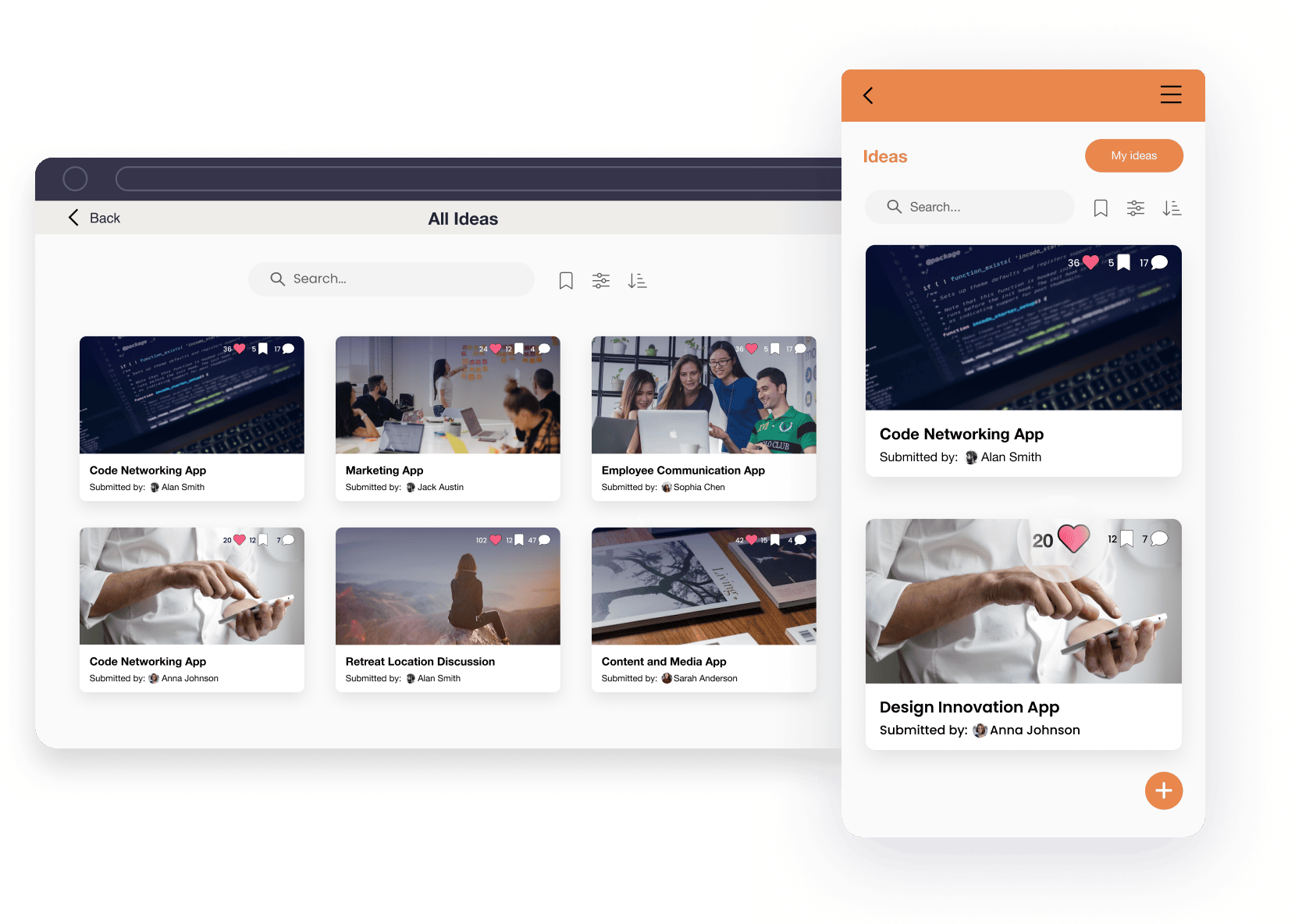
You can tap into the full potential of your workforce. It empowers your team to engage with each other’s ideas, allowing them to like, comment, and prioritize the most impactful ones. This collaborative approach ensures that your organization’s future is shaped based on collective employee intelligence.
Give your employees a place to propose ideas for solving your organizational challenges
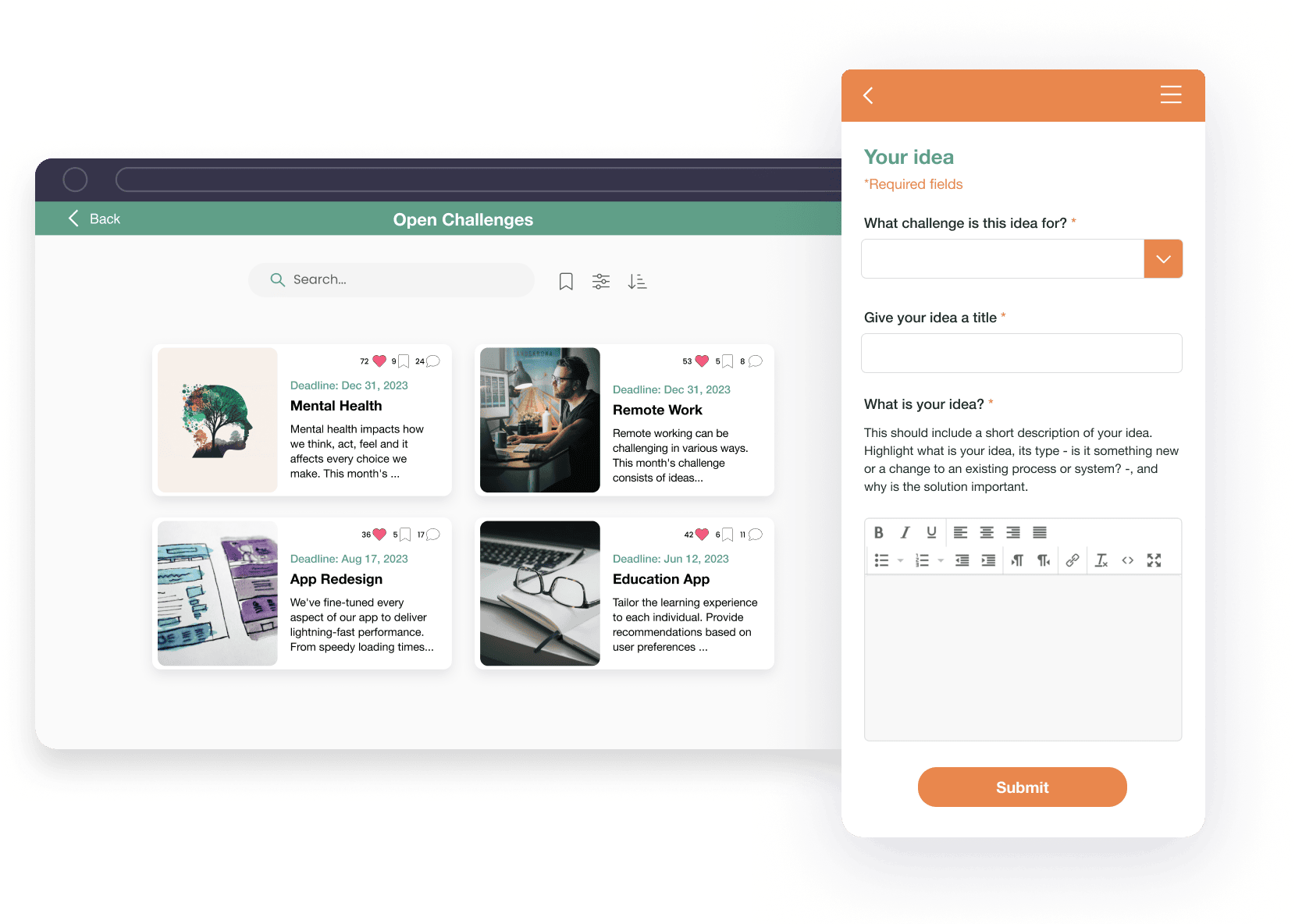
Fliplet provides a dedicated platform for sparking creativity and open innovation. By offering a space for sharing and discussing ideas, it encourages employees to contribute innovative solutions. This feature creates a culture where every team member feels empowered to propose and explore fresh ideas.
Manage your entire innovation cycle in one view

Oversee your entire innovation cycle, from ideation to implementation, all within a single app. By embracing this streamlined approach, you enhance efficiency and effectiveness in your innovation endeavors. Fliplet ensures that your ideas seamlessly progress from concept to reality, making innovation a smoother journey.
With Fliplet, you can streamline your idea generation process, organize your thoughts effectively, and turn those concepts into actionable plans. Whether you’re working solo or within a team, Fliplet can be a catalyst for harnessing your creative potential. So, stay tuned as we uncover how Fliplet’s innovation solution can elevate your idea generation game. See how Fliplet can help you drive impactful innovation, try Fliplet for free.
Another software you may want to use is Figma. Figma is a versatile design and collaboration tool that can be effectively used for mind mapping. Its collaborative features allow teams to visually brainstorm ideas and create mind maps in real-time. Figma’s flexibility and cloud-based platform make it an ideal choice for remote teams to collaborate on ideation and organize their thoughts efficiently.
Thirdly, IdeaScale is a dedicated idea management software that provides organizations with a platform to collect, evaluate, and implement ideas systematically.
These tools are instrumental in innovation management by providing a structured framework for idea collection, evaluation, and implementation. They encourage collaboration, transparency, and the efficient management of innovative projects, ultimately driving the growth and success of organizations.
Idea Generation in Specialized Fields
Idea generation isn’t limited to any particular industry or field; it’s a universal process that can be applied across various domains. Here, we explore how idea generation plays a crucial role in two specialized fields: entrepreneurship and product development.
Entrepreneurship
Idea generation is the foundation upon which innovative startups are built. Entrepreneurs constantly seek unique solutions to existing problems or identify untapped opportunities in the market. Idea generation in entrepreneurship involves market research, identifying pain points, and envisioning novel products or services that can address these needs.
Entrepreneurs often rely on brainstorming sessions, customer feedback, and industry trends to generate innovative ideas that can disrupt traditional markets or create entirely new ones. The ability to generate and refine ideas is a hallmark of successful entrepreneurship.
Product Development
Idea generation is a fundamental aspect of product development. Companies engaged in product development must continuously innovate to stay competitive and meet the evolving needs of their customers. Idea generation in this context often involves cross-functional teams working together to ideate and conceptualize new products or enhance existing ones.
Techniques such as design thinking, rapid prototyping, and user-centered design play a pivotal role in generating ideas that can lead to the creation of successful products. Product development teams focus on translating customer insights, market trends, and technological advancements into actionable ideas that result in tangible products with a competitive edge.
Navigating Challenges in Idea Generation
Idea generation, while essential for innovation, comes with its set of challenges. Understanding and overcoming these hurdles is critical for a successful ideation process. In this section, we’ll explore some common pitfalls and misconceptions and emphasize the role of feedback and iteration in idea generation.
Common Pitfalls and Misconceptions
- Overemphasis on Perfection: One common pitfall is striving for perfect ideas from the outset. This can lead to a paralysis of analysis and hinder creativity. In reality, ideas often start as rough concepts and evolve through iterations.
- Lack of Diverse Perspectives: Restricting ideation to a narrow group can limit the variety of ideas generated. Diverse perspectives, backgrounds, and experiences are essential for innovative thinking.
- Ignoring Feedback: Failing to seek and incorporate feedback from peers, stakeholders, or customers can result in missed opportunities for improvement and refinement.
- Fear of Failure: The fear of failure can stifle creativity. Embracing the idea that not all ideas need to succeed can free individuals and teams to explore more daring and innovative concepts.
- Rigid Thinking: Sticking to preconceived ideas or established processes can hinder creativity. Being open to new approaches and possibilities is crucial for idea generation.
The Role of Feedback and Iteration
- Enhanced Idea Quality: Feedback provides valuable insights and perspectives that can help refine and enhance the quality of ideas.
- Validation: It ensures that ideas align with organizational goals, customer needs, and market trends, reducing the risk of pursuing unviable concepts.
- Continuous Improvement: Iteration allows for continuous improvement of ideas. Concepts often start as rough drafts and evolve through cycles of refinement and testing.
- Risk Mitigation: Iterative processes help identify and mitigate potential risks and challenges associated with implementing ideas.
- Alignment with Objectives: Feedback and iteration ensure that ideas remain aligned with organizational objectives and strategies.
Challenges in the idea generation process can be effectively addressed with Fliplet’s innovation solution, a comprehensive tool designed for the nuances of ideation. Fliplet’s platform facilitates collaboration, captures feedback, and streamlines the iteration process, ensuring that valuable ideas are refined and transformed into impactful solutions.
Measuring and Managing Your Ideas
Effectively measuring and managing ideas are essential aspects of the idea generation and innovation process. In this section, we’ll explore key performance indicators (KPIs) and metrics for evaluating idea quality and viability, as well as provide tips for successfully managing and refining ideas.
KPIs and Metrics for Evaluating Idea Quality and Viability
- Idea Impact Score: Assess the potential impact of an idea on your organization. Consider factors like potential revenue, cost savings, or improved customer satisfaction.
- Feasibility Score: Evaluate the feasibility of implementing the idea. Assess whether the necessary resources, skills, and technology are available.
- Customer Feedback and Validation: Measure the level of positive feedback and validation from customers or target users. Customer surveys, interviews, and user testing can provide valuable insights.
- Time-to-Value: Evaluate how quickly an idea can be implemented and start delivering value to the organization.
- ROI Projection: Estimate the return on investment (ROI) the idea is expected to generate over a specific period.
- Alignment with Strategic Objectives: Assess how well the idea aligns with the organization’s strategic objectives and long-term goals.
- Cost-Benefit Analysis: Compare the potential benefits of the idea against the estimated implementation costs.
Tips for Successfully Managing and Refining Ideas
- Establish Clear Idea Ownership: Assign responsibility for each idea to a specific team member or stakeholder to ensure accountability.
- Regular Idea Reviews: Conduct regular reviews and discussions to track the progress of ideas and identify areas for improvement.
- Prioritization: Prioritize ideas based on their impact, feasibility, and alignment with organizational goals.
- Iterate and Refine: Encourage continuous refinement and iteration of ideas based on feedback and changing circumstances.
- Create Cross-Functional Teams: Form cross-functional teams to work on ideas, leveraging diverse skills and expertise.
- Document and Archive Ideas: Maintain a centralized repository of ideas, even if they are not immediately pursued, as they may become valuable in the future.
- Communication and Transparency: Ensure clear communication and transparency throughout the idea management process to keep all stakeholders informed.
- Celebrate Successes: Recognize and celebrate the successful implementation of ideas to motivate teams and enhance a culture of innovation.
Effectively measuring, managing, and refining ideas using these KPIs and tips can lead to the successful execution of impactful ideas, driving innovation and growth within your organization.
Building an Effective Idea Generation Team
Creating an effective idea generation team is pivotal for successful innovation within any organization. To achieve this, start by assembling a team with diverse skills and backgrounds to bring varied perspectives and creativity to the table. Encourage collaboration among team members from different departments to approach challenges comprehensively, creating a culture of cross-functional cooperation.
Designate passionate individuals as innovation champions to inspire and motivate the team, driving the ideation process forward. Define clear roles and responsibilities within the team to ensure a structured approach and accountability. Invest in training and development programs to equip team members with idea generation tools and techniques, generating continuous learning and industry awareness. Implement incentive and recognition programs to reward innovative contributions and boost morale.
Provide access to idea management tools like Fliplet to facilitate collaboration, capture ideas, and track progress efficiently. Schedule frequent ideation sessions to encourage brainstorming and idea sharing, cultivating a culture of open and constructive feedback among team members. Enable hands-on experience by allowing team members to prototype and test ideas, and encourage exploration of ideas from other industries or domains to inspire innovation. Ensure leadership provides the necessary support and resources for the idea generation team, as leadership buy-in is crucial for the success of innovation initiatives. By following these steps, organizations can build a dynamic idea generation team poised to drive impactful innovation.
Why Idea Generation is so Important
In conclusion, adopting a culture of continuous learning and innovation is essential for organizations looking to stay competitive and drive growth. It’s crucial to encourage your teams to explore new ideas and experiment with various techniques to unlock their full creative potential.
Additionally, consider leveraging tools like Fliplet’s Innovation Management solution, which can streamline the idea generation process, facilitate collaboration, and help manage and refine ideas effectively. Embrace innovation as an ongoing journey, and you’ll be well-positioned to tackle future challenges with fresh, innovative solutions.
FAQs
What is idea generation?
Idea generation is the process of coming up with new and creative concepts or solutions. It’s like brainstorming sessions where people think of innovative ways to solve problems or create something new.
Which idea generation method involves keeping ideas in sight and well-organized?
The method called “Mind Mapping” helps keep ideas in sight and organized. It’s like drawing a tree with branches; the main idea is the trunk, and related thoughts or sub-ideas branch out from it. This visual representation helps people see connections and organize their thoughts clearly.
What takes place during the idea generation stage of the new-product development process?
During this stage, people brainstorm and come up with various concepts for a new product. It’s like planting many seeds and seeing which ones have the potential to grow. The aim is to gather as many ideas as possible and then pick the best ones to develop further.




